Darrell Brooks trial: Week 3 recap, judge threatens to end defense
WAUKESHA, Wis. - Darrell Brooks could call his mother to the stand and testify himself Monday, Oct. 24 before jury instructions begin in the Waukesha Christmas parade trial. This, after a shocking end to the third week of the trial, which saw the defendant give the judge a "stare down" that she said scared her to the point where she had to call for a break in the proceedings.
During the third week of the trial, the state rested its case after calling 57 witnesses over 11 days. Before resting, the prosecution focused on Brooks' arrest the night of the parade attack and Brooks' subsequent interviews with detectives. The jury was also taken out of the courtroom to view the red SUV.
Brooks then delivered his deferred opening statement, crying as he told the jury he was speaking "from the heart." Brooks then began to call defense witnesses, representing himself.
MONDAY, Oct. 17
On Monday morning, the first day of the third week of the trial, prosecutors read Brooks a pretrial offer which they said was given to Brooks' former attorneys in July 2021 and January 2022. Brooks fired his attorney days before the start of the trial. Brooks said he never received this pretrial offer. The state noted it would involve Brooks pleading guilty to 67 of the charges in the case. He would then receive six life sentences for the six homicide charges filed against him and unspecified prison on the other counts.
Brooks continued his subject matter jurisdiction arguments Monday, as he has every day during the trial. It relates to Brooks' "sovereign citizen" arguments. The Southern Poverty Law Center says "sovereign citizens believe they are not under the jurisdiction of the federal government and consider themselves exempt from U.S. law." Judge Jennifer Dorow referred to a written ruling issued on this matter Friday, Oct. 14.
TESTIMONY: Sean Backler, Waukesha homeowner
The first witness for the prosecution Monday was Sean Backler, who accused Brooks of "trespassing" in his yard the day of the Waukesha Christmas Parade. He identified Brooks in court as the person he saw in his yard that day. He said something seemed "off" about Brooks.
"He was wearing a T-shirt. No shoes. Sweating. His eyes were huge. He was just acting -- when he came out from the garage, he asked if I could call him an Uber," Backler said.
Backler said he didn't call an Uber, telling Brooks to leave.
On cross, Backler said he called the non-emergency line to report this encounter.
"I said the individual was either black, mixed or Latino," said Backler.
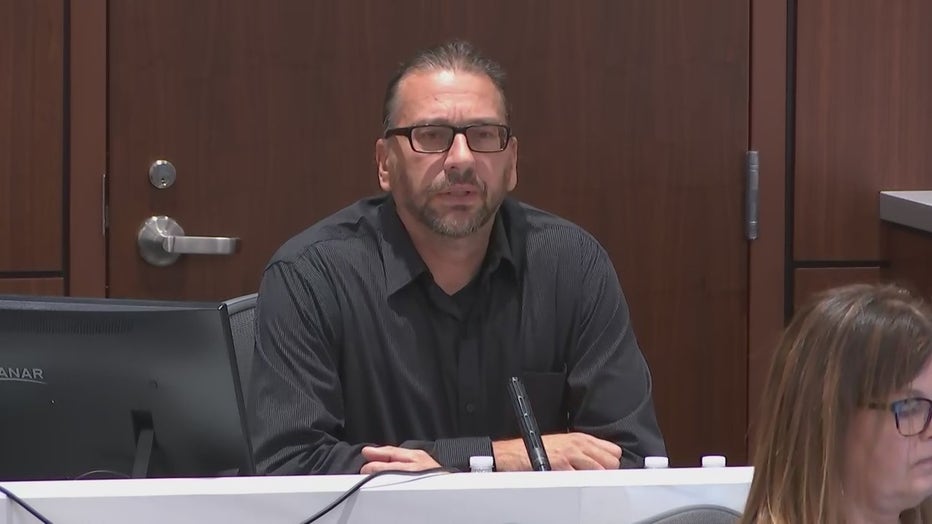
Sean Backler
Backler added, "I was positive it was you."
"Who's you?" Brooks asked.
"You. I’m looking at you," said Backler.
Backler said the next morning, he got the police report and mugshot.
"I said, 'That’s the guy,'" said Backler. "You were the guy in my yard. I was curious if you were the person and the one who did the atrocities at the parade."
TESTIMONY: Domanic Caproon, Waukesha homeowner
Domanic Caproon was then called to the stand by the state and said rooks came up his driveway, lifted his shirt and said he did not have any weapons and needed a phone to call an Uber. Caproon stated he handed him a phone.
Caproon positively identified Brooks as the man he met in his driveway. He testified he remembered a tattoo above Brooks' eye.
"He wasn’t wearing a jacket or shoes," said Caproon. "He was wearing blue jeans and a red T-shirt."
Caproon later indicated he provided police with his phone so investigators could see who Brooks called on that date.
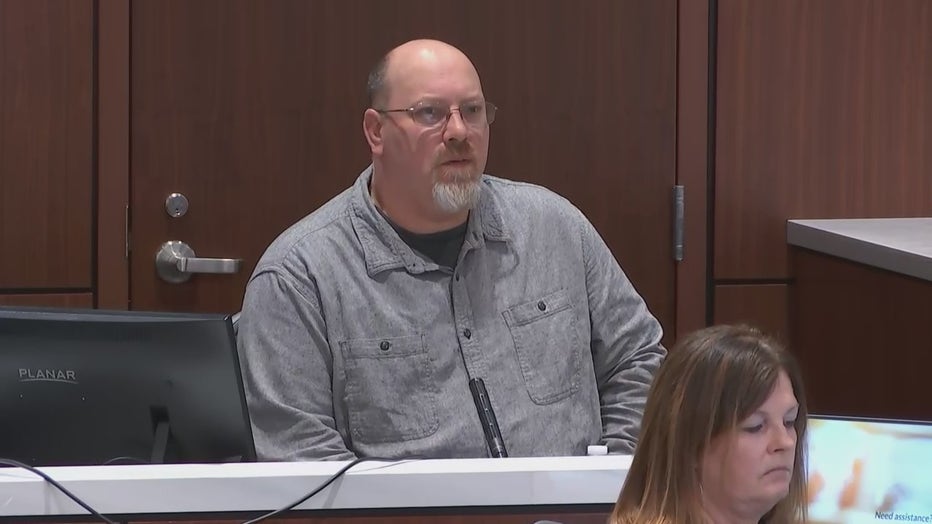
Domanic Caproon
"He called somebody, which, at the time, I thought was Uber," said Caproon. "A lady called me. I asked if she was an Uber. She said, ‘Is she an Uber?’"
He said Brooks eventually left.
TESTIMONY: Erin Cordes, Waukesha homeowner
Erin Cordes testified for the state next on Monday, telling the court she was near the end of the parade route when she saw an officer fire "three shots at the vehicle."
"Our kids were in the middle of the road picking up candy at that time," said Cordes.
She said they parked on Elizabeth Street near Aries Industries. That's where she and her family ran into Darrell Books when he came out of the bushes. She positively identified Brooks in court after he removed his mask.
"It was a windy, cold night," said Cordes. "He was shivering, had a red shirt on and no shoes."
Cordes said he asked for a phone, telling Cordes and her husband, "I’m not going to hurt you. I just need to use your phone."
Cordes stated Brooks appeared to be calling his mother to call him an Uber.
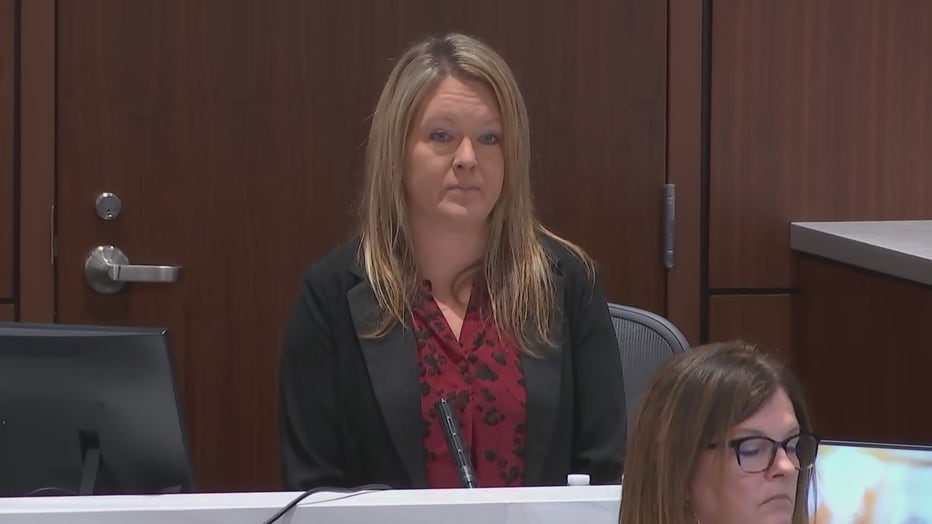
Erin Cordes
"There was a sense of urgency, and he needed it now," Cordes said.
Cordes also testified Brooks was cold and asked her and her husband where there was a place he could warm up.
Video was shown of Brooks walking up to the doors of Aires Industries before turning away.
On cross, Cordes told Brooks she couldn't see into the SUV and didn't know if any of the bullets fired by the officer hit it.
TESTIMONY: Anthony Winters, Lyft driver
Anthony Winters, a Lyft driver, testified next for the state. Winters testified he was called for a ride Aires Industries.
"The fare came in from Dawn," said Winters. Dawn is Brooks' mother's first name. "I was told I was looking for a Black guy with dreadlocks."
When Winters arrived at the pickup location, he said the parking lot was empty. There was no one there.
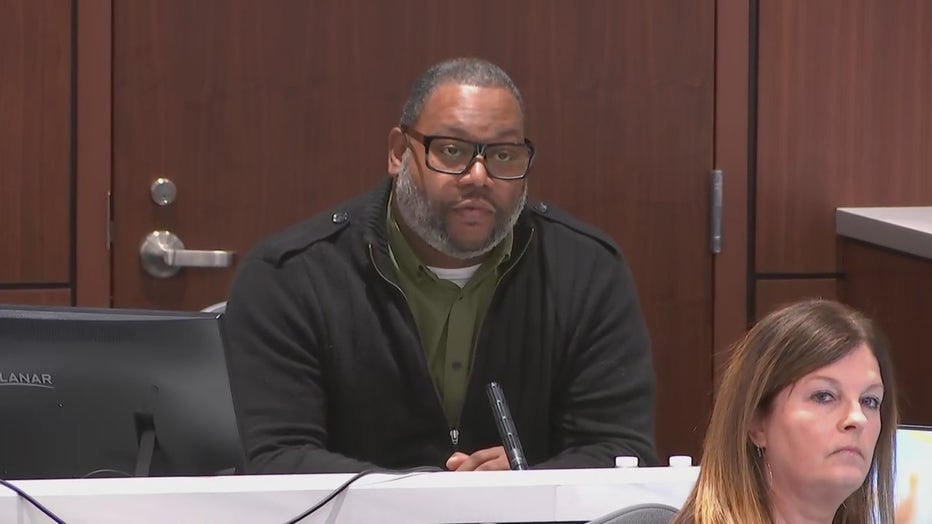
Anthony Winters
"I got out of the car, knocked on the door, sent a message saying there was no one around," Winters testified.
Winters said he waited more than seven minutes. Nobody showed up, and he then canceled the ride.
TESTIMONY: Daniel Rider, Ring camera captured Brooks at his doorstep
The state then called Daniel Rider, who gave Ring camera footage to law enforcement and the media showing Brooks at his front door after the parade attack.
"There was a man who rang my Ring doorbell, said he was homeless and cold and needed my phone," Rider said, noting the man was wearing a T-shirt and no shoes.
Rider said he invited the man in, made him and sandwich and offered him a coat and a phone. He said Brooks appeared to be on the phone with his mother.
He said after Brooks left, he came back in because he forgot his ID.
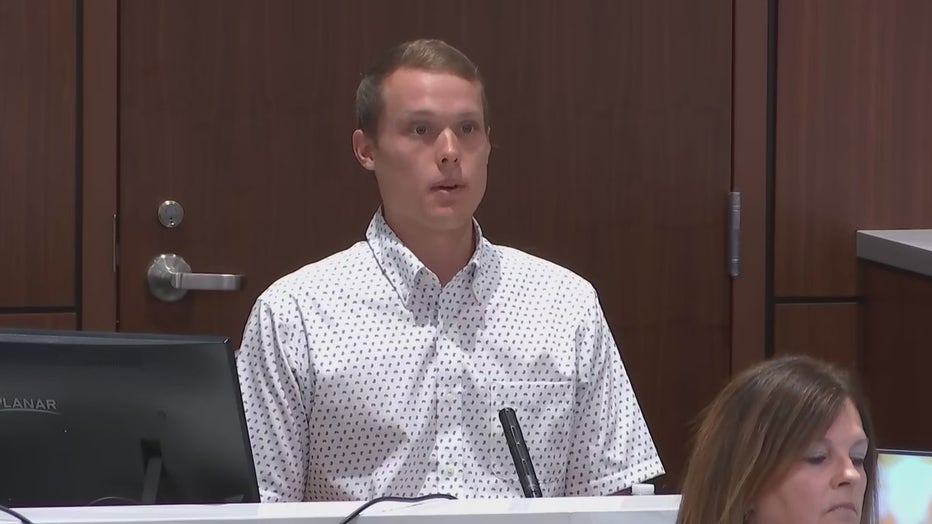
Daniel Rider
"The suspect came back a minute later, asking to come back inside and that he left his ID. I went back in to look for it but didn’t let him back inside. There was nothing left in my house," said Rider.
On cross, Brooks asked Rider about the fact that the footage was on social media.
"I released it," said Rider. "The news wanted the footage. I thought this was good footage for this community to see the suspect in cuffs, so I released it."
He said he was paid for the footage.
"We were getting bombarded with media requests, and we worked with an agent and I don’t know what we got on the back end," he said.
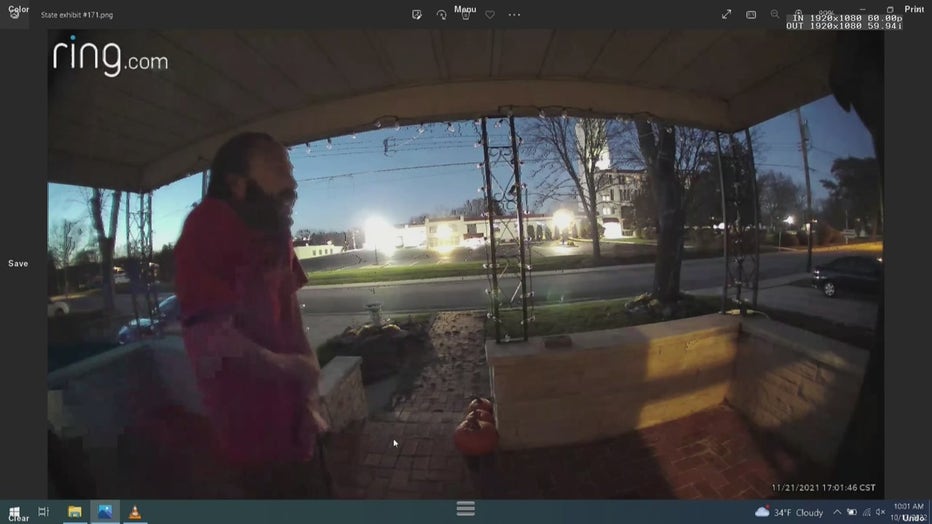
Darrell Brooks at Daniel Rider's home
TESTIMONY: Rebecca Carpenter, Big Bend police officer, body camera footage of Brook's arrest
The court then saw body camera video of Brooks' arrest the night of Nov. 21, 2021, when Big Bend Police Officer Rebecca Carpenter was called to testify.
Carpenter said she to Elizabeth Street after hearing there was a man going door-to-door asking for people's phones to call an Uber. She said she and other officers started looking for this person.
Officer Carpenter told the court that during her encounter with Brooks on Elizabeth Street, he identified himself as "Darrell Brooks." She first saw him on Daniel Rider's porch, wearing a T-shirt and no shoes.
"I was coming from the parade route. I have a friend over there. Did I do something?" Brooks asked Carpenter in the body camera video.
In the body camera video, Brooks is heard asking Carpenter, 'Can I please just sit up?" He told a second officer his name was "Darrell Brooks." Carpenter asked, "Where are your shoes?" Brooks said his flip-flops were in Rider’s house. No shoes were inside.
Carpenter said she took an ID, a credit card and a car key from Brooks. Carpenter said she found a sandwich in Brooks’ pocket. Rider made Brooks a sandwich after knocking on his door, telling Rider he was homeless.
Darrell Brooks trial: Big Bend officer testifies about the arrest of Brooks
Officer Rebecca Carpenter told the court that during her encounter with Brooks on Elizabeth Street, he identified himself as Darrell Brooks. In the body camera video, Brooks is heard asking Carpenter, 'Can I please just sit up?" He told a second officer his name was "Darrell Brooks."
No weapons were found during a search of Brooks, who was taken to a squad car because he "was not dressed for the weather."
Carpenter testified Brooks was wearing "jogging pants." On cross, Brooks questioned Carpenter about whether the pants the suspect was wearing in the body camera video were really blue jeans.
He also asked about the police report.
"Do you recall writing the subject was being detained for investigative purposes…" asked Brooks.
"At the time, I was not fully aware of the circumstances," said Carpenter.
She said she "knew people had been hurt" and she knew shots were fired, but she didn't know the "magnitude."
"Just that something violent had happened," she said.
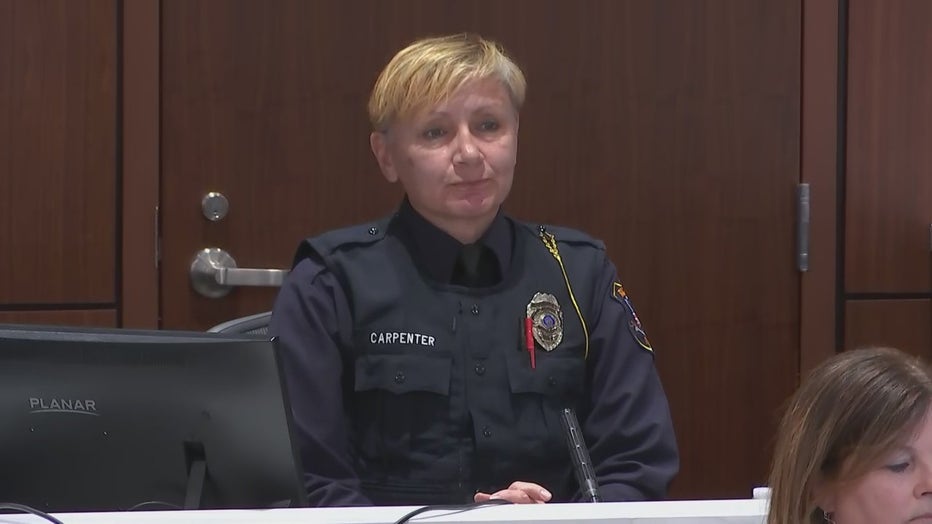
Rebecca Carpenter
Brooks asked if she gave him a reason as to why he was being detained. She said he was informed he was being detained for investigative purposes -- "an answer that's appropriate for the circumstances."
"I did not have a lot of information to give you, sir," said Carpenter.
"You keep saying 'you,'" said Brooks. "Who is the 'you' that you keep referring to?"
"You, Darrell Brooks. The defendant. Seated at the defense table," said Carpenter.
On re-direct, prosecutors asked whether Brooks was thrown to the ground during his arrest. A police officer later testified Brooks was taken to the hospital complaining of injuries after his arrest.
"We did not," said Carpenter.
TESTIMONY: Garrett Luling, Waukesha police officer, responded to Brooks' detention
Garrett Luling testified he responded to Elizabeth Street where Brooks was arrested. He identified the subject being detained as "Darrell Brooks." He identified "Darrell Brooks" as the defendant.
He said he did not see Brooks slammed to the ground or any use of force toward Brooks.
Luling testified he searched Brooks before he was placed into a squad and found a "black Ford key."
Luling said Brooks questioned why he was being detained. He said he told Brooks he was being detained because he matched the description from an incident in the downtown area. He didn't mention the parade.
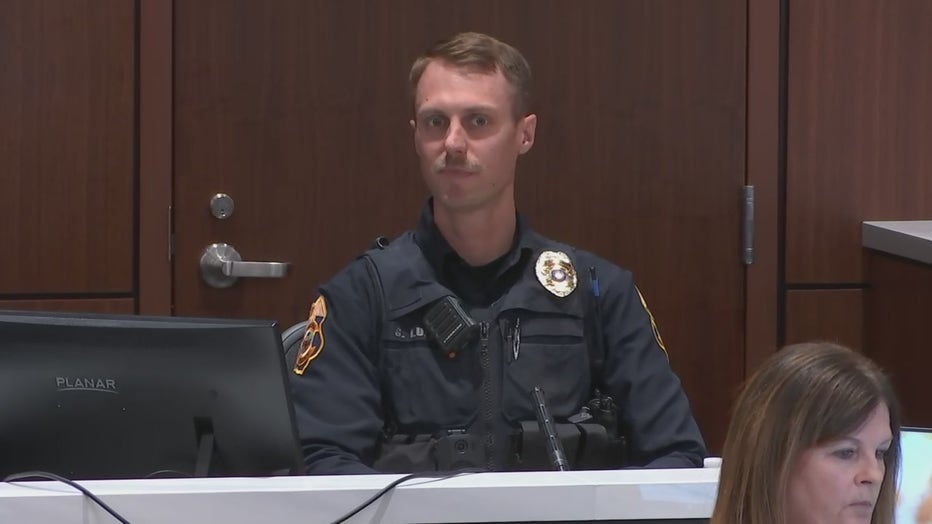
Garrett Luling
On cross, Brooks asked Luling whether Officer Moss said a witness indicated they saw multiple suspects exit the vehicle. Luling said two officers heard there may have been more than one suspect who ran from the vehicle.
Brooks asked Luling what the person being detained was wearing. He stated a red T-shirt and blue jeans. Brooks asked if they were jogging pants. Luling confirmed they were blue jeans.
The defendant asked why the person was being detained.
"You were being detained for being involved in a crash in the downtown area," said Luling.
Brooks asked Luling, "Where is the footage of you finding the key?" to the Ford SUV. Luling said he was not wearing a body camera when he responded on Elizabeth Street.
TESTIMONY: Draelon Leija, Waukesha police officer, drove Brooks to Muskego PD
Waukesha Police Officer Draelon Leija testified about his transporting Brooks to the Muskego Police Department from Waukesha Memorial Hospital, where he was taken for treatment of injuries he claimed to have sustained during his arrest on Elizabeth Street.
He said Waukesha PD had no holding cells and Muskego was willing to hold Brooks on mutual aid.
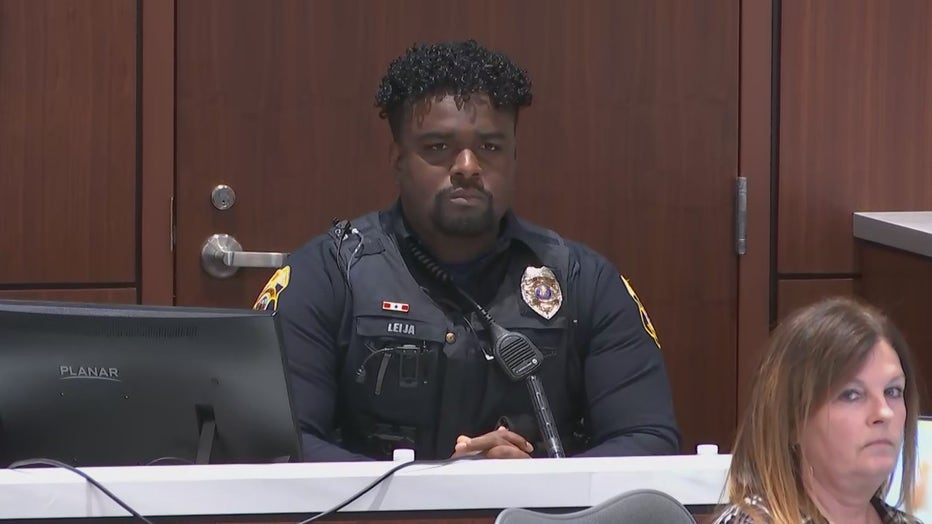
Draelon Leija
As they drove, Leija said Brooks, noticing the police presence due to the parade response, said, "Damn, it looks like they’re dealing with something heavy."
Leija said he watched Brooks overnight.
TESTIMONY: Detective Jay Carpenter, Waukesha Police Department, interviewed Brooks
Next up for the state was Waukesha Police Detective Jay Carpenter, who was actually marching in the parade with the Honor Guard unit. He then responded to the scene after the red SUV went through. He described how the incident evolved into two different forms called for ambulances to tend to the wounded while dispatchers also learned someone was loitering around 500 Elizabeth that some believed may have been a suspect.
"The descriptions… were comparable, nearly identical to the descriptions I was hearing for the driver in the parade incident," said Carpenter.
He said he heard officers from a separate jurisdiction had come in contact with the suspect and that he was in custody, identified as Darrell Brooks.
"Information that I heard over police radio was an African American male, blue jeans and a red T-shirt," said Carpenter.
He said when he responded to the scene on Elizabeth Street, Brooks was already in custody and handcuffed. Carpenter said Brooks was placed in the rear of a Waukesha police car, taken into custody for loitering and suspected as the driver in the parade incident.
He was asked if he had any information about the vehicle used when coming in contact with the suspect.
"Yes, a red SUV that was actually a red Ford Escape," said Carpenter. "The vehicle was parked over on Maple Avenue, which is about 2.5-3 blocks west of Elizabeth Street where Mr. Brooks was located and taken into custody."
He said he spoke with Brooks at a substation on Les Paul Avenue. He identified the defendant as "Darrell Brooks."
Carpenter was asked in Brooks looked different in court than he did on Nov. 21, 2021.
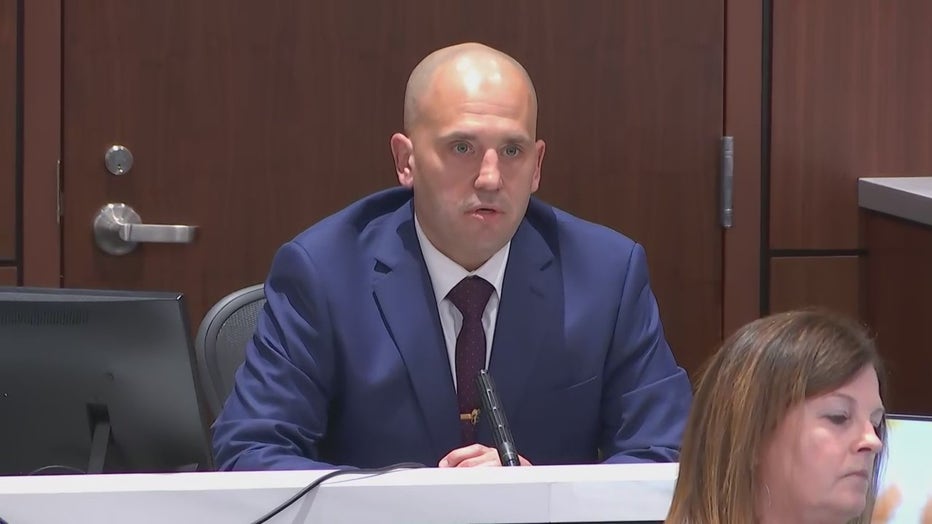
Detective Jay Carpenter
"At the time of the incident, Mr. Brooks had longer hair, braided style hair that probably went halfway down his back," said Carpenter.
He said Brooks had a beard at the time that was longer.
He said he received items that were on Brooks' person at the time of his arrest, including an ID card with Darrell Brooks' name and photo on it, a Quest card with Brooks' name on it, along with credit cards with Brooks' name on them and an EBT card with Brooks' girlfriend's name on it. He added there was $4 in cash and a Ford key.
Carpenter was shown a still image from "the middle of the parade" and identified the driver of the red SUV as Darrell Brooks.
While speaking with Brooks at a police substation, Carpenter said he complained of injuries during his arrest, so he was taken to the hospital.
"Mr. Brooks told us his shoulder was injured when he was arrested. He indicated the arresting officers slammed him to the ground," said Carpenter.
He said he reviewed Rebecca Carpenter's body camera video of Brooks' arrest and saw "no" use of force.
"There was no force used at all," said Det. Carpenter. "Mr. Brooks was given verbal directions by officers to get down onto the ground, and he did so entirely on his own."
At the hospital, Carpenter said, "We escorted Mr. Brooks into a room, trying to keep him away from the victims."
Doctors ultimately cleared him.
Carpenter interviewed Brooks at the hospital, recorded through hospital security cameras and Carpenter's phone for audio. Two FBI agents joined him.
"The FBI became involved in the investigation early on because we were not certain at that point whether this was a terrorist incident," said Carpenter.
He said when the FBI agents introduced themselves to Brooks, Brooks was "very surprised."
TUESDAY, Oct. 18
To begin the day Tuesday, Brooks made his subject matter jurisdiction arguments again.
Judge Dorow noted a second copy of her written statement on this matter was provided to Brooks.
"I know you saw it because you tore it up yesterday," said Dorow.
Darrell Brooks trial: Brooks rolls eyes at judge prior to start of Tuesday testimony
Before testimony started on Tuesday, Oct. 18, Darrell Brooks and Judge Jennifer Dorow had a tense exchange that lasted more than ten minutes. it ended with the entry of the jury into the courtroom.
There was then a warning from prosecutors about Brooks' interviews with law enforcement that would be played in court. Deputy District Attorney Lesli Boese told the court that extreme care had been taken to ensure no portion of these interviews would be played containing evidence that had previously been ruled inadmissible by the court. Before the trial, the judge said no references to other cases (such as previous domestic cases involving Brooks' ex, Erika Patterson) would be allowed during the parade trial. Boese made note that, while Brooks would have the opportunity to cross-examine, should he choose to play a portion of the video/audio that would "open the door" to the evidence ruled inadmissible, she would feel "compelled to address it," saying Brooks would do so "as his own risk."
TESTIMONY: Waukesha Police Detective Jay Carpenter, interviewed Brooks
Darrell Brooks trial: Audio from FBI interview played in court
Audio from an FBI interview of Darrell Brooks was played in court for the state's case.
Detective Carpenter was then brought back to the stand and audio was played of his interview with Brooks at the hospital.
"FBI. FBI?!" Brooks said in the recording.
"We’re just kind of helping out because we’re so short-staffed tonight, so that’s all it is," an agent said.
"Y’all for real? The FBI for real?" Brooks later said.
"We get that reaction from most people," the agent said.
"No cause it’s like, am I in a movie right now?" asked Brooks. "Y’all pranking me or something?"
Carpenter then began speaking with Brooks, indicating he had "one side" of the story and needed "Darrell's side."
In speaking with Carpenter, Brooks had light chatter, talk that included Brooks' children, where he went to high school and even Brooks mentioning this was the first time he had ever talked with anyone from the FBI.
"I was just like, I need to get a Uber. I have money on my Cash App card. I’m not trying to rob anybody! I’m not trying to break in, and obviously, you can tell I’m not drunk. I’m not under the influence of anything," Brooks told Carpenter, referencing reports of someone going door-to-door on Elizabeth Street.
Brooks eventually told Carpenter he did not want to speak with him.
After Brooks' transport from the hospital to Muskego PD, Carpenter responded in the morning and tried to talk to Brooks again. Carpenter said that morning, he learned more information about the Frame Park domestic incident between Brooks and Patterson that prosecutors say preceded the parade attack.
"Only thing I want to know is why in the hell am I being charged with anything?" said Brooks, noting Patterson's allegations against him were "total BS."
"She’s the one that acts the fool, and I’m the one that pays for it!" Brooks added.
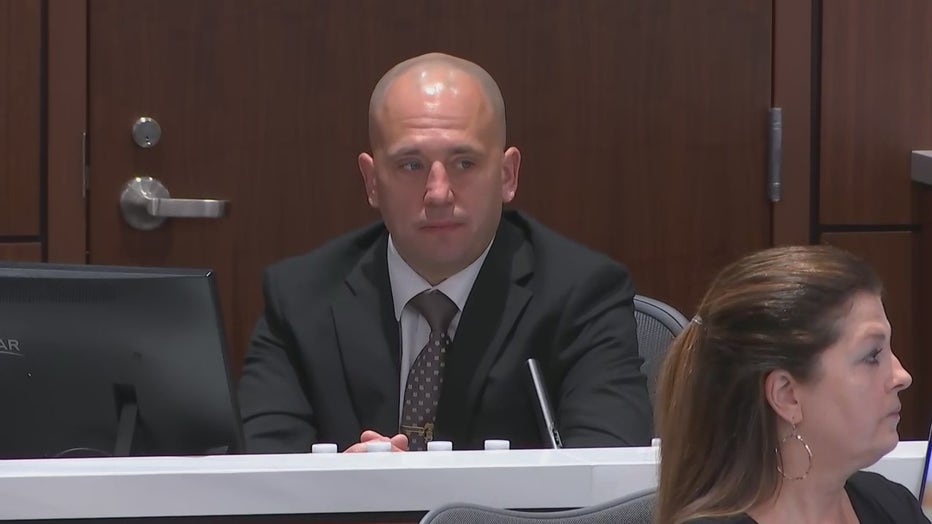
Detective Jay Carpenter
Brooks said he came to Waukesha Nov. 21 to watch the Packers game with a friend at a house, but he could not provide the address or the last name of his friend.
When asked about Patterson, Brooks said he was meeting with her because she had been holding money for him. He said he told her, "I'm not supposed to be around you."
"I love you to death. You my baby mama. I’ll meet up with you to get the money. I’m not going to have sex with you. I’m not going to hang out with you. None of that," said Brooks.
Brooks again asked to know what he was being charged with.
"Listen, Carpenter, you’ve been straight with me. I just want to know what am I looking at, so I can let my girls know," said Brooks.
TESTIMONY: Juan Marquez, first witness for Brooks as he represents himself
Juan Marquez was called out of order at this point in the trial due to the availability of a Spanish interpreter.
Juan Marquez testified that he was marching in the Waukesha Christmas Parade with his wife and son with the Catholic Communities of Waukesha. At some point, he said he felt something hit his leg. When Marquez was asked by Brooks if he remembered what that was, Marquez said, "A vehicle."
Brooks let it slip that Marquez originally told the FBI the SUV was black. Marquez told the court he could not remember what color the truck was that struck him on the parade route.
On cross, Boese asked if Marquez ever heard a horn honking before he was hit by the SUV. He said "no."

Juan Marquez
Marquez said after he was hit, he was thrown between 15-20 feet and his body "flew through the air." He said his son, David, was also struck. Marquez had to have surgery on his leg.
At this point, Dorow kicked Brooks out of the courtroom after warning him to "stop with the commentary," noting 10 interruptions before 10:30 a.m.
"Are you holding me in contempt?" Brooks asked the judge.
The judge noted Brooks "objected to every question by the state, and when the court overruled, his commentary became much more audible, clearly showing disrespect for the court and proceedings."
"It has been very apparent that any time the jury has been brought in, Brooks has accused the court of misconduct or bias," said Dorow. "This court is not doing any such thing. He has forfeited his right to be present."
Dorow addressed Brooks' question of contempt, noting that he faces the possibility of life in prison and "contempt is not a viable path for the court."
"It would allow him to profit from his own wrongdoing. There would be a delay in the proceedings. That is not something this court is even willing to do," said Dorow.
Darrell Brooks trial: Defendant tossed from court during witness cross-examination
Judge Jennifer Dorow tossed Darrell Brooks from court on Tuesday morning, Oct. 18 for being disruptive to the cross-examination of his own defense witness. He repeatedly objected to questions posed to the witness. Those were overruled -- and eventually the judge tossed Brooks. He was going to rejoin the proceedings from an adjacent courtroom.
TESTIMONY: Detective Carpenter, Waukesha Police Department, interviewed Brooks
After this, Detective Carpenter returned to the stand to resume testimony regarding his interviews with Brooks.
Brooks said he came in a Kia with a friend, noting he had a license but not a vehicle.
"My mom doesn’t know how to drive," said Brooks. "She doesn’t have a car."
Prosecutors say Brooks was driving his mother's red SUV in the parade attack.
"Whose car did you drive out here?" Carpenter asked.
"I didn't drive at all," said Brooks.
Darrell Brooks trial: Interview with Brooks after the Waukesha Christmas parade incident
Darrell Brooks trial: Interview with Brooks after the Waukesha Christmas parade incident.
Brooks talked about meeting with Erika Patterson and watching the Packers game with his friend.
This interview took place Nov. 22, one day after the Christmas parade attack.
"Yesterday was a mistake," said Brooks. "I should have just watched the game."
"You did not come out here in a tan Kia. You have a key in your pocket for a car in your mom’s name. For the love of God, for yourself and family, tell me what happened?" said Carpenter in the interview.
"What am I being investigated for?" asked Brooks.
"We have been cool this whole time…" said Brooks.
"You have lied to us. You came out in the red Ford Escape. You had the key. I want to give you a chance to reset, start over. You aren’t giving us an accurate story," said Carpenter.
"All I want to know is am I charged with anything?" said Brooks. "I’ll tell you anything you want to know."
Darrell Brooks trial: More video from law enforcement interview of Brooks
Darrell Brooks trial: More video from law enforcement interview of Brooks.
In his testimony, Carpenter noted that Brooks did not walk to Frame Park to meet Patterson, but rather, took the same SUV that went through the parade route.
In the next interview clip, Brooks acknowledged the red SUV for the first time.
"It's my mom's car," he said.
In the next clip, Brooks said he was "getting railroaded," again demanding to know what was going on and what he was being charged with.
"If I tell you… will you be straight up with me with everything that I’m facing?" said Brooks.
Carpenter testified that Brooks never told him someone else was driving the SUV.
In the next video clip, Brooks finds out that "a lot of people got hurt" at the parade.
"Are you serious?" asked Brooks. "Like, bad? A stroller? So a kid got hurt?"
Brooks then made a joke and laughed.
Darrell Brooks trial: Defendant asks, "What am I facing?" when questioned
Darrell Brooks trial: Defendant asks, "What am I facing?" when questioned
Carpenter testified Brooks never asked how any of the injured were doing. Carpenter told the jury Brooks never told them why he drove through the parade or what was going through his mind.
In one interview, Carpenter showed Brooks a video on his phone, which he later testified showed the SUV going through the parade. Brooks wouldn't watch.
"I understand my life is over," said Brooks. "This is how my story ends."
On cross, Brooks asked why the suspect was questioned at the hospital versus the police station. Carpenter noted that Brooks requested medical clearance and "there is a risk" with any prisoner transport, so they wanted to avoid that risk. Carpenter noted that there were four officers, including himself, at the hospital, so they were confident they could secure Brooks.
He also asked Carpenter about standard procedure in detaining people suspected of crimes.
"You just said you try not to assume until you have all the facts. Is it fair to say all the information you had before you were not sure about?" asked Brooks.
"I wasn’t sure if you were the driver initially, but I was sure you were involved," said Carpenter.
"And you knew that to be fact?" asked Brooks.
"Yes. The information provided was that you were involved," said Carpenter.
Brooks asked about the significance of the FBI being present during his interviews. Carpenter again said there were concerns this was a terror attack.
Brooks asked what he meant by "this."
"When you drove your vehicle through the parade and struck people..." said Carpenter.
Carpenter was asked if the FBI continued their investigation. The witness noted it was eventually run strictly by Waukesha police. Brooks asked why.
"My understanding is there wasn’t a terrorism link," said Carpenter.
Brooks asked if Carpenter had ever conducted an interrogation with the FBI present, and he said not prior to this interrogation of Brooks.
Brooks also questioned Carpenter about a comment he made in the interrogation that the FBI was present because they were "short-staffed." Brooks then asked for that portion to be replayed.
"They're just kind of helping out because we're so short-staffed tonight," Carpenter says in the audio recording.
"From hearing the audio… do you recall saying the FBI was present because you were short-staffed?" asked Brooks.
Darrell Brooks trial: Brooks shown pictures, video of what happened at the Waukesha Christmas parade
Darrell Brooks trial: Brooks shown pictures, video of what happened at the Waukesha Christmas parade.
"That is my voice. I don’t recall saying that in the moment, but that is my voice," said Carpenter. "We were just very short on resources with what happened down at the parade route and the mass casualties and the amount of officers it took to secure that location. We were very short on people."
Brooks asked if the FBI is usually present in a "situation of short-staffing." Carpenter said "no."
There was then a discussion about Brooks being read his Miranda rights during the "first interrogation attempt" at the hospital, and Carpenter said, "You indicated you didn't wish to speak with me."
Brooks asked why Carpenter continued to record even though Brooks invoked his Fifth Amendment.
"We are trained in our police department, when you do an interrogation, that the recording is to be left on pretty much until you affect transport…" said Carpenter.
Brooks wants Carpenter's initial hospital interrogation stricken
Judge Dorow then dismissed the court to take up two legal issues -- first, police policy (why Brooks thought it was relevant in regard to his questioning of Carpenter) and second, the questions he was asking, Dorow said, went to a legal issue the court has already determined.
Brooks said the police policy was relevant because he believed it should be stated for the record why Carpenter continued his phone recording despite Brooks invoking his Fifth Amendment right.
"At that point, the interrogation has to stop completely," Brooks said. "I believe that if that’s, in fact, policy, it should be proven. It should be proven that that’s a fact, that it’s a real policy. For all we know, he could just be saying that it’s a policy…"
The judge said he was assuming facts that weren’t in evidence, and she didn’t see the relevance. She said Brooks was making assumptions.
"Frankly, his conduct isn’t on trial. We’re not here on a police misconduct trial. I’m not saying that some of this information might not be relevant to his credibility...Why do you believe those policies relate to an issue of fact in this case or otherwise go to your defense?"
Brooks said he believed anything related to the first interrogation shouldn't be admitted as evidence per his Fifth Amendment right.

Detective Jay Carpenter
The judge said that was a legal determination she had already made.
"To make this trial about that interrogation, it’s not relevant," Dorow said. "I’ve already ruled on the admissibility. It’s a legal determination."
Judge Dorow said she gave Brooks some leeway in his questioning Carpenter and said she believed he was questioning Carpenter on legal issues that are not relevant, trying to illicit info out of Carpenter that is not relevant.
"I know the law on this area, and I know when a subject invokes their Fifth Amendment… because you only invoked your right to remain silent, they waited to question you until a sufficient amount of time had passed, in addition to a number of other reasons," Dorow said.
TESTIMONY: Detective Jay Carpenter, Waukesha Police Department, more Brooks' cross
As for the second interrogation at Muskego PD, Carpenter said he explained to Brooks that they had more information about the domestic incident before the parade attack, "and that's what I was looking to speak to you about."
Brooks questioned Carpenter about the Miranda rights, and Carpenter said they were read 15 minutes into the interrogation.
"I’m not required to read them immediately… I read them before I asked you any specific questions about that event," said Carpenter.
Brooks asked if there was any reason why he wouldn’t explain the real reason why the detainee was being detained.
"At that point, the (Frame Park) domestic was part of the reason you were being held in custody," said Carpenter.
Carpenter testified that, at a certain point, the parade became the primary focus of the investigation/questioning.
Carpenter did admit there was "information I withheld from you" during the interrogations.
"I wanted to be sure the information you gave me was truthful," said Carpenter.
"I think it’s important to note – and this is proven by evidence – you lied to me about your mother owning the vehicle. You lied about coming out here in a possible tan Kia," said Carpenter, adding that Brooks also "lied about being body-slammed by officers" during his arrest on Elizabeth Street.
The defendant asked Carpenter about his showing a video to the detainee in a "forceful" manner.
"I was attempting to show you a video of when you drove your vehicle through the parade route," said Carpenter. "I felt it was very important for you to see the damage that was caused by the incident."
Carpenter testified about items seized from Brooks' jail cell to be tested for DNA evidence.
During questioning by Brooks about the arrest on Elizabeth Street Carpenter said when he arrived, "I believe you were already in the back seat of a squad car. You were detained."
"The suspect," said Brooks.
"The suspect is you, Darrell Brooks," said Carpenter.
Brooks' last question to Carpenter was whether there were reports of multiple suspects in connection with the parade incident.
"Yes. It was chaotic early on. There were reports of possible multiple suspects early on," said Carpenter.
On redirect, Boese asked about "excited utterances," and Carpenter explained that this involves statements made by an individual of their own accord and not in response to any question. Carpenter said "yes" when asked if it is important to capture these utterances and "yes" when asked if that's one reason to consider a recording after an interview is over.
Boese asked if Brooks ever said there was anyone else in the red SUV, possibly Erika Patterson. Carpenter said "no."
WEDNESDAY, Oct. 19
As the proceedings began Wednesday morning, Judge Dorow informed the court that two jurors tested positive for COVID-19. She then brought the entire jury panel in to question them as to any health concerns. All said they had "no" concerns. Brooks questioned the judge as to whether all jurors should be tested since there was potential exposure. She said she would not mandate testing, and noted Brooks had not been exposed due to his distance from the jury.
Darrell Brooks trial: COVID concerns from juror
A second juror has raised COVID-19 concerns during the Darrell Brooks trial. It was addressed by the judge on Wednesday, Oct. 19.
TESTIMONY: Steven Schlomann, IT director at Waukesha School District
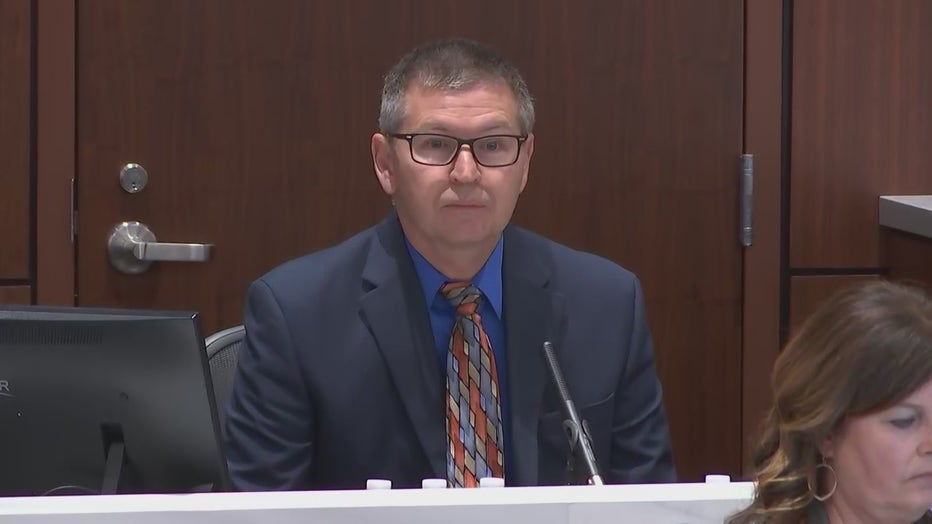
Steven Schlomann, Waukesha School District IT director – Schlomann testified he was contacted by Waukesha police in regards to cameras on school district property on Maple Avenue. He said he found video that might be helpful to police and turned it o
First to testify Wednesday was Steven Schlomann, Waukesha School District IT director. Schlomann told the court there are roughly eight cameras on a school district property at 222 Maple. He said he was contacted by Waukesha police about the cameras and whether they had captured anything on the day of the Waukesha Christmas Parade.
Schlomann said he found video that may be helpful to police and turned it over to them.
TESTIMONY: Robert Stone II, homeowner with security camera
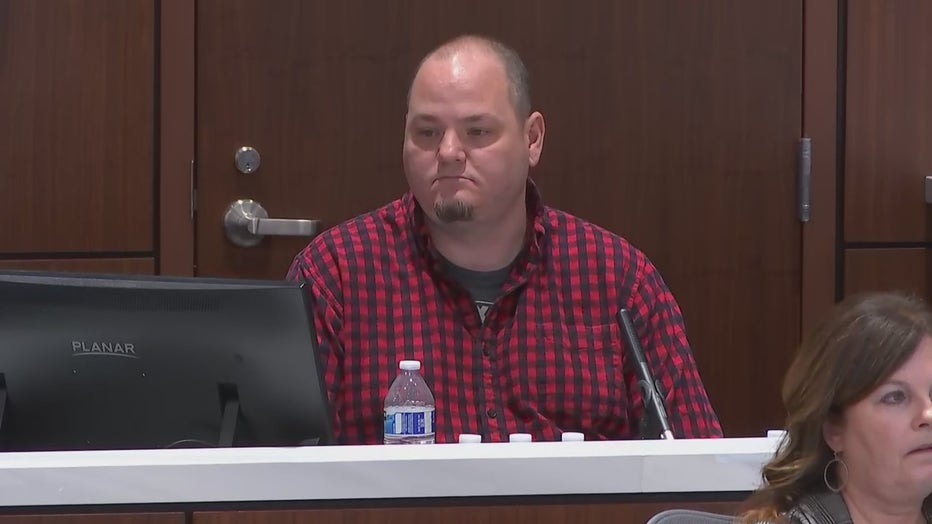
Robert Stone II
Robert Stone II then testified for the state. He lives on Dunbar Avenue and has security cameras. Stone told the court he retrieved footage from those cameras following the Waukesha Christmas parade incident and turned it in to police.
TESTIMONY: Andrew Amerson, homeowner with security camera

Andrew Amerson
A third person with security camera access was next to testify for the state in the Brooks trial. Andrew Amerson lives on Dunbar Avenue and also has surveillance cameras.
"My cameras are evident from the street," Amerson said. "Police wanted to look at them."
TESTIMONY: Leonard Miller, homeowner with security camera
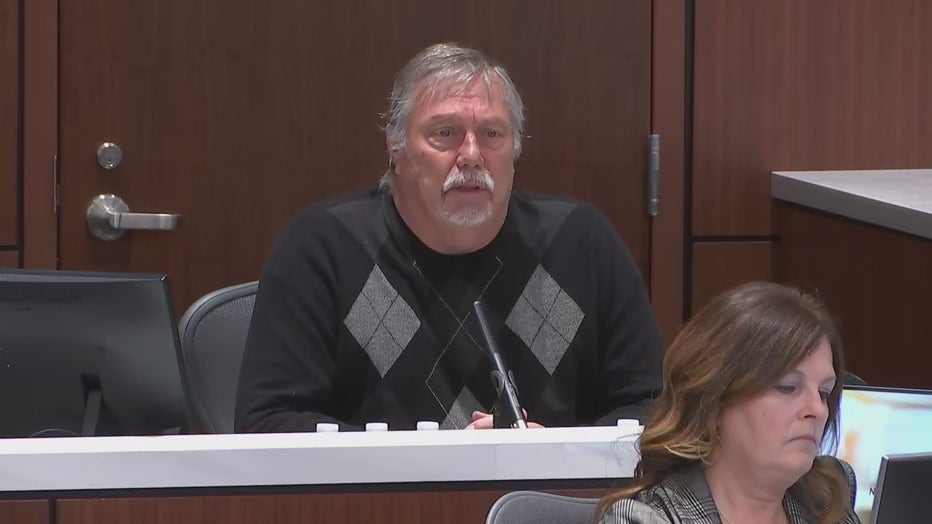
Leonard Miller
Leonard Miller, another homeowner with a security camera, testified for the state. He lives on Central Avenue.
"I started looking through my cameras. I saw someone running up my driveway," Miller said, adding that he did not recognize the person
TESTIMONY: Kyle Becker, Waukesha Police Department, involved in Maple Street search
Next to take the stand for the state was Waukesha Police Officer Kyle Becker. Prosecutors indicated he was part of a search team canvassing the area immediately following the Waukesha Christmas parade incident.
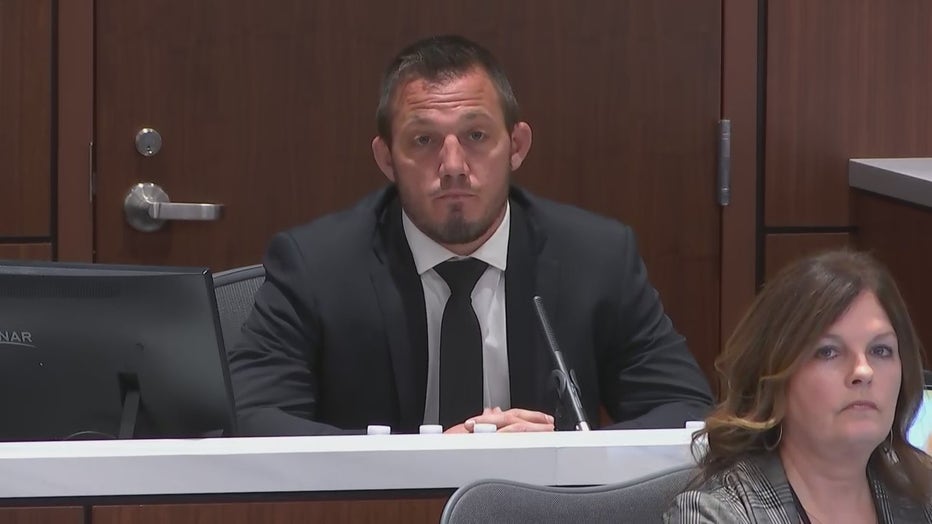
Kyle Becker
Becker testified about the items that investigators located at a residence on Maple, including a blue sandal.
"I thought Mr. Brooks lost the first sandal jumping the fence, "Becker said. "I located the gray hooded sweatshirt that Brooks was wearing in the parade, and in close proximity was the other sandal," said Becker.
On cross, Brooks asked Becker if items are "usually kept for this length of time.
"Yes. Until the investigation is complete," said Becker.
Darrell Brooks trial: Waukesha police officer testifies about evidence recovered
Waukesha Police Officer Kyle Becker testified about evidence recovered as part of the investigation after the Waukesha Christmas parade tragedy. The evidence included a sandal and sweatshirt believed to belong to Darrell Brooks.
Darrell Brooks trial: Defendant's cross-examination creates numerous objections
Darrell Brooks trial: Defendant's cross-examination creates numerous objections
Jurors view red SUV
Around 11:30 a.m. Wednesday, jurors were taken to see the red SUV in a secure garage that's part of the court complex.
FOX6 News was told Brooks did attend that "jury view."
There were previous discussions about whether Brooks would be present. Brooks told the court he did not wish to be present and did not see the relevance of the jury view occurring at all. Dorow told Brooks his lack of consent would not stop the jury view.
She initially demanded that he be present for the jury view, but a day later, she changed her mind, telling Brooks she thought about it overnight and would not require him to be there.
In the end, he did attend.
Brooks trial; a look at the red SUV
Jurors in the trial of Darrell Brooks, the man accused in the Waukesha Christmas Parade attack, got the chance to see the red SUV that allegedly drove through. Here's a look at what ther jury was allowed to see. (Courtesy: CourtTV)
Online court records show Brooks did a "walk around" of the vehicle with a bailiff. Brooks' restraints were removed before the jury entered. Jurors were escorted around the vehicle once before leaving the garage. Footage was provided of the vehicle in the garage after the jury view.
There was no talking allowed during the viewing. Jurors were not allowed to take notebooks. The walls of the Waukesha County Jail garage were covered to avoid any chance of bias in front of the jury.
TESTIMONY: Justin Rowe, Waukesha Police Department detective, mapped Brooks' path
After the jury view, Justin Rowe, Waukesha Police Department detective, took the stand. He was tasked with going to the Maple Avenue area to search for items discarded by Darrell Brooks.
Detective Rowe mapped Brooks’ path the night of the Waukesha Christmas Parade.
Rowe said the dashed red line in the map is the path Brooks took on foot. It shows Officer Salyers (who was off duty) in close proximity to where investigators say Brooks ditched the SUV.
Further south on the map, Rowe said Brooks stopped to try and get cellphones and "call an Uber." Prosecutors say Brooks was calling his mother.
The map and timeline show Officer Scholten fired shots at Brooks at 4:39 p.m. Nov. 21 as Brooks left the parade route. Brooks was arrested at 5:14 p.m.
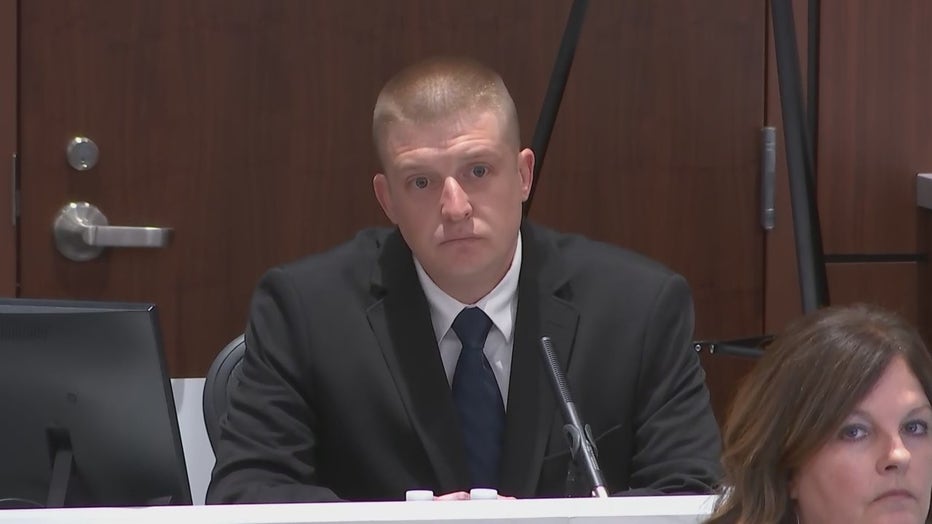
Justin Rowe
Rowe said there are some areas they don’t have video of Brooks traveling.
On cross, Brooks asked how police know he crossed N. West Ave if there were no cameras or witnesses present.
"You were arrested on Elizabeth Street," said Rowe.
In other words, Brooks got across the street somehow.
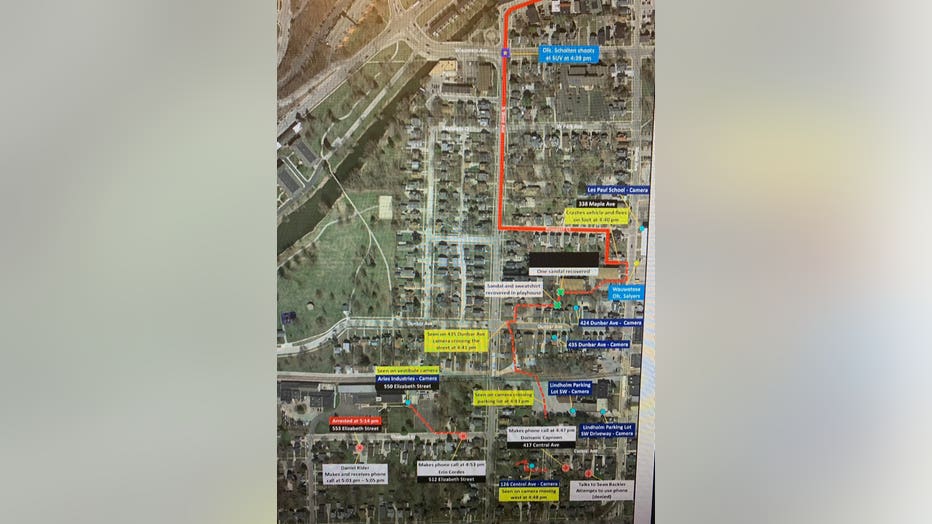
TESTIMONY: Ryan Schultz, Wisconsin State Patrol, examined red SUV
Next up for the state was Ryan Schultz, Wisconsin State Patrol mechanical inspector.
Schultz testified he looked at the SUV to see if there was anything wrong with it prior to the crash that would have contributed to it crashing.
"The vehicle had quite a bit of front end damage, hood folded up in the air, there was quite a bit of debris stuck on it..." he said.
Schultz said the brakes on the SUV were in "good, working condition," and the brakes still "fully" functioned after the crash. He said the tires were "evenly worn."
He said there were no obstructions to the throttle pedal, which acted just as it should. The power steering system was also working properly.
He testified he did not open the hood of the vehicle because of the DNA evidence on it.
Schultz said when he ran the ignition, there were no diagnostic codes that came up. He said there were no recalls on this vehicle, only an extended service warranty from Ford that elapsed due to the vehicle’s mileage.
Schultz was asked if he observed anything that would have prevented the vehicle from stopping of the brake pedal was applied, and he said "no." Boese followed up by asking whether he observed anything that would have contributed to the crashes the SUV was involved in. He said "no."
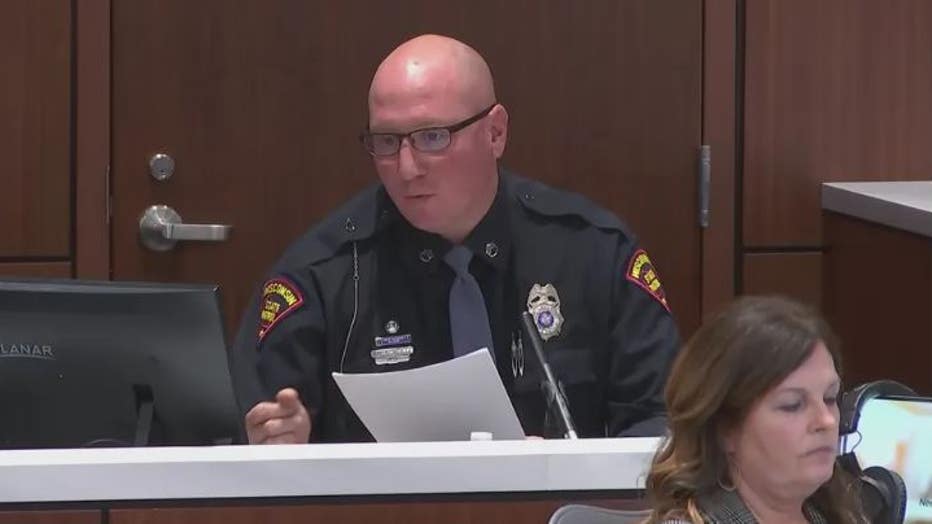
On cross, the witness said there was a coolant leak in that there was no coolant in the vehicle. Brooks questioned Schultz about a loose ball joint in the front left of the vehicle. Brooks asked how this would affect the vehicle, and Schultz said it would only wear down, eventually causing the wheel not to be able to steer, but the wheel on the red SUV was still steerable.
Brooks also questioned Schultz about the report he wrote, and Schultz said the high-mount brake lamp was inoperable when he inspected it, meaning someone traveling behind the red SUV would not be able to see the brake light that's located on the hatch of the SUV. His report stated it was not known if this was working before the crash.
"I would have no way to tell when that light bulb went out," said Schultz.
On redirect, Boese referenced the high-mount lamp and asked whether the left brake light was working, and Schultz said the left stop lamp was working. Boese then asked about the ball joint and whether you can safely operate a vehicle if the ball and socket joint is not separated. Schultz said "yes," and he said the ball and socket were not separated on this vehicle.
Boese then asked if the engine controls acceleration, braking, steering or gear shifting. He said "no."
Boese then asked for clarification on what was leaking from the vehicle, if anything.
"Yes, so water pump, water coolant, it’s all interchangeable as far as the cooling system for the engine goes, and the cooling system was low at the time of the inspection and had been leaking, but from where, I don’t know," said Schultz.
Boese then asked if that controls the steering, the braking or the acceleration, and Schultz said "no."
Finally, Boese asked if the use of the high beams on the SUV would have been any assistance if the vehicle was coming up behind people, and Schultz said "no."
Darrell Brooks trial: Judge admonishes defendant for frequent interruptions during testimony
Darrell Brooks trial: Judge admonishes defendant for frequent interruptions during testimony
Judge calls for break: 'I don't find it funny'
After sending the jury off for a 15-minute afternoon break, the judge asked Brooks what he was referring to when he said, "That’s hilarious." Brooks said he was referring to the fact he saw some of the questions he asked were overruled, but the state could ask, and his objections were thrown to the side.
"I just think that’s funny," Brooks said.
"Well, sir, I don’t find it funny," Dorow said.
Dorow noted Brooks made disparaging remarks during Schultz' testimony.
Boese said she took note of one of Brooks’ comments. His response was, "Stop trying to be slick."
"Yes, I did say that," said Brooks.
TESTIMONY: Chris Johnson, Wisconsin State Crime Lab, performed DNA analyses
Next up for the state was Chris Johnson, chief of the Office of Crime scene response for the division of forensic sciences within the Wisconsin State Crime Lab. He talked about how he was called out to Maple Street to process a vehicle abandoned in a driveway. He responded with a crime scene response photographer.
"It was reported to me that the vehicle was more than likely involved in running through the Waukesha Christmas Parade," said Johnson.
He talked about how he collected "fragile" items from the SUV, including some examination gloves and a winter hat, along with a headband around the driver door mirror of the SUV, which was broken. Johnson noted during transport, this item would have most likely fallen off.
He said the front bumper of the SUV had to be lifted up with bungee cords and resecured for the tow truck transport so that it would not be further damaged.
Johnson said from Maple Street, the SUV was taken to the Waukesha County Sheriff's Department's secure facility.
Johnson said the inside and outside of the vehicle were inspected for DNA evidence.
He said he found a hat on the front passenger seat cushion.
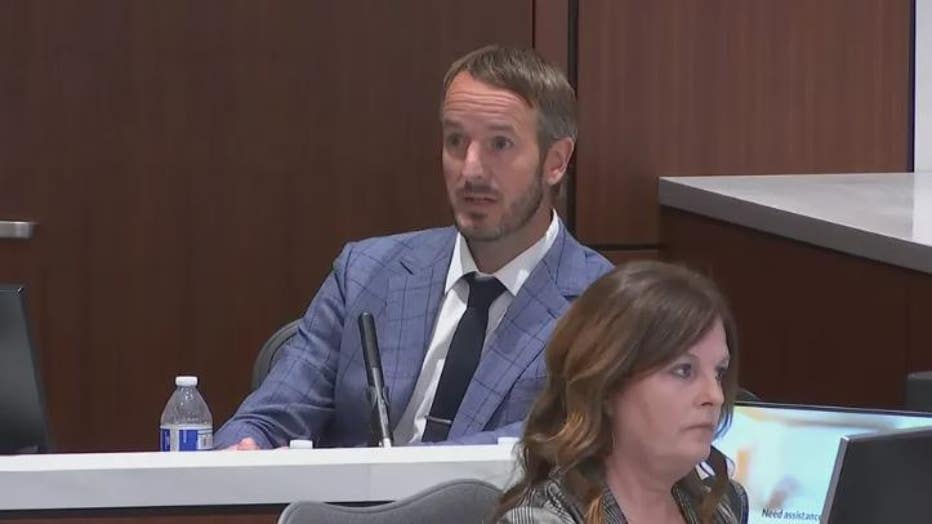
He said a detachable hood from a jacket and a winter hat were found pinned to the windshield by a windshield wiper arm and the "crumpled hood."
He said there was paperwork inside the vehicle that had the name "Darrell E. Brooks" on it.
Brooks admonished again
The judge excused the jury for a legal discussion, and Brooks nearly got removed to the adjacent courtroom due to his interruptions. Brooks was upset after it was noted that Opper placed some evidence on the table for Johnson, the witness.
"Whoa, whoa, whoa, whoa. On the table? How did it get on the table?" Brooks asked.
"No one is doing something that is prohibited by this court…" said Dorow.
She warned him that if he interrupted the proceedings again, he would forfeit his right to be present in the main courtroom.
Brooks responded by saying, "You might as well remove me then." Brooks told the judge she did not know what he was trying to do.
"You’re making a record of me trying to look bad. It’s not going to work!" said Brooks.
As Brooks yelled, Dorow advised Brooks to be respectful.
"Don’t nobody tell me what to do. I don’t tell nobody else what to do. I’ve never told you to do anything at all," said Brooks. "I’m a grown man with grown kids. Don’t nobody talk to me like that. Nobody."
Darrell Brooks trial: Defendant, judge spar over questioning of witnesses
Darrell Brooks trial: Defendant, judge spar over questioning of witnesses
TESTIMONY: Chris Johnson, Wisconsin State Crime Lab, Brooks' cross-examination
Brooks began his cross-examination of Johnson by asking about the DNA analysis. Brooks specifically asked if Johnson, who did not perform the DNA analysis, knew the results. Johnson said he spoke with the investigator who performed the DNA analysis, but he said "I don't know the exact results, no."
The witness was asked by Brooks about the headband on the vehicle and how it got there. Johnson said it likely got there when the vehicle came into contact with something or someone who was wearing it. Brooks asked if he knew that for sure, and he said "no."
He said the examination of the vehicle itself took "probably over 40 hours," not including the report he wrote, which was a summary of his inspection.
"The vehicle needed a comprehensive evaluation, processing, examination of pretty much every side and surface of that vehicle," said Johnson.
On redirect, Opper asked what Johnson meant when he said the vehicle was secured when he arrived on Maple Street.
"The perimeter was secured with crime scene tape, and there were officers that were standing at the location where the vehicle was," said Johnson.
He said anyone that would have come up to the vehicle would have been stopped by law enforcement.
TESTIMONY: Trevor Naleid, senior forensic analyst, performed DNA analyses
The state's last witness Wednesday was Trevor Naleid, Wisconsin Department of Justice State Crime Lab senior forensic scientist in the DNA analysis unit.
Naleid said he developed DNA profiles from the swabs of the steering wheel of the SUV.
"It was a two-person mixture with at least one male," said Naleid, adding that he was able to identify those people using software. "Based on it being a two-person mixture, Erika Patterson and Darrell Brooks are both very strong support for inclusion."
He said the swab of the gear shift was a three-person mixture with at least one male contributor. The software result was "the same as the steering wheel."
"So Erika Patterson and Darrell Brooks are both very strong support for inclusion," said Naleid.
In layman's terms, Naleid said it was at least one quadrillion times more likely the DNA was from Brooks/Patterson (and someone else for the gear shift) versus three random people.

Trevor Naleid
As for the hat that was found in the SUV, Naleid said it was a two-person mixture with at least one male contributor.
"Erika Patterson has a very strong support for exclusion. Darrell Brooks has strong support for exclusion. Wilhelm Hospel (Milwaukee Dancing Grannies volunteer killed in the parade attack) has very strong support for inclusion. He is above that one quadrillion threshold that we have," said Naleid.
A sweatshirt was also analyzed. He said a reddish brown stain on the right sleeve tested presumptive positive for blood. Five hairs were also retrieved. Naleid said the DNA was a three-person mixture with at least one male contributor, with the same mixture on the cuff links. The stain was a two-person mixture with at least one male.
Using the software, Naleid said as to the collar and the cuffs, "Mr. Brooks has very strong support for inclusion." As to the stain, "Both Erika Patterson and Darrell Brooks have very strong support for inclusion."
On cross, Brooks asked for clarification on what Naleid meant when he said DNA "mixture."
"A mixture just means that it is more than one person present in the profile," said Naleid.
Brooks questioned Naleid about why it took so long for his analysis to be completed. The witness noted the evidentiary items weren't received until January, and he completed his report in April. Naleid said he generated 583 pages, and his final report was 15.
Brooks also questioned the witness about the process of obtaining the evidentiary items and where they went after he was done with them. Naleid said they were unsealed when he began his analysis, and they were returned to the evidence technician and put back into storage when he was done.
Brooks asked about the "three-person mixtures" and questioned whether there is DNA that was found that is still unknown.
"That's correct," said Naleid.
On redirect, Opper asked about the source of the hairs on the sweatshirt. Naleid said Darrell Brooks was the source.
THURSDAY, Oct. 20
The prosecution rested Thursday after calling 57 witnesses over 11 days. Then, Darrell Brooks cried as he delivered his deferred opening statement and began calling witnesses, representing himself in this trial.
As proceedings began Thursday morning, the judge noted she provided Brooks with an excerpt from her judicial bench book to help him prepare his opening statement, which she said should be a roadmap/framework of his case to help the jury better understand his evidence.
She said his opening statement must not contain reference to subject matter jurisdiction, something Brooks brought up multiple times every day during the trial.
Brooks noted he was "pretty aware that subject matter jurisdiction wouldn't be part of my opening or closing statement."
"Okay. Great," said Dorow.
Prosecutors move to amend complaint
Prosecutors then introduced a motion Prosecutors asked to change it to "near Frame Park." This particular count relates to the fight prosecutors say Brooks was involved in with his ex-girlfriend, Erika Patterson, before the Christmas parade attack. Prosecutors argued that this change would be more in line with Patterson's testimony and noted it was "a very small change in the charging documents."
Brooks argued that this case had been charged for "the better part of a year."
"If there was one word that needed to be changed, there was ample time for it to be changed," he said.
The judge granted the state's request.
State recalls Detective Thomas Casey
The court then discussed prosecutors' request to recall Detective Casey, who previously testified over two days earlier in the trial. Prosecutors noted there wouldn't be any duplication in their questioning. Rather, they said his first testimony focused on the parade layout, and they now wanted to ask about victim identification, driver identification and vehicle identification -- things that had been addressed in testimony since Casey was first on the stand.
Prosecutors argued that, "as the lead detective in the case," it would assist the jury in understanding some of the things on the back end that he was involved in.
Casey initially testified that Brooks hit him with the red SUV before the parade attack, and he tried to stop the vehicle. He was on scene after the parade attack and later became lead detective.
Brooks argued that he felt the state had been "efficient in their presentation." He said their arguments seemed to be "an attempt to get more questions in that could have been asked in the first place." Brooks also argued that Casey was excused from his subpoena in this case after his prior testimony.
Dorow allowed the state to recall Casey.
Brooks prepares ‘counter’ plea offer
Before the jury was brought in, Brooks noted the state's pretrial offer, which would involve Brooks pleading guilty to certain counts and receiving six life sentences for the homicide charges plus unspecified prison on other convictions. Brooks claimed he never had that pretrial offer until the trial. Prosecutors claimed it was given to Brooks' prior attorneys on at least two occasions.
Brooks said Thursday morning he was in the process of putting together "a counteroffer."
TESTIMONY: Detective Thomas Casey, Waukesha Police Department, recalled by prosecution
Called back to the stand by the state, Casey told the court that police detectives were sent to five different hospitals to identify possible victims as they came in. As part of the process, the detective said, officials had to come up with parameters that would positively identify a true victim. He said the victims had to be in the street of the parade route and receive hospital care. The detective said people who were injured after the fact, from other instances, were not considered victims. In other words, there were more victims from the parade attack than those associated with the 76 total counts filed against Brooks in this case – including 61 counts of first-degree recklessly endangering safety related to the injured victims.
The detective testified investigators obtained "300 to 400 videos" of the parade incident. He stated he watched all of them and asserted Brooks was driving the red SUV through the parade in all of them.
"I've never seen anyone driving the SUV other than the defendant. None of the videos we looked at showed anyone else in the vehicle," Casey said. "Never showed the vehicle coming to a complete stop on the parade route."
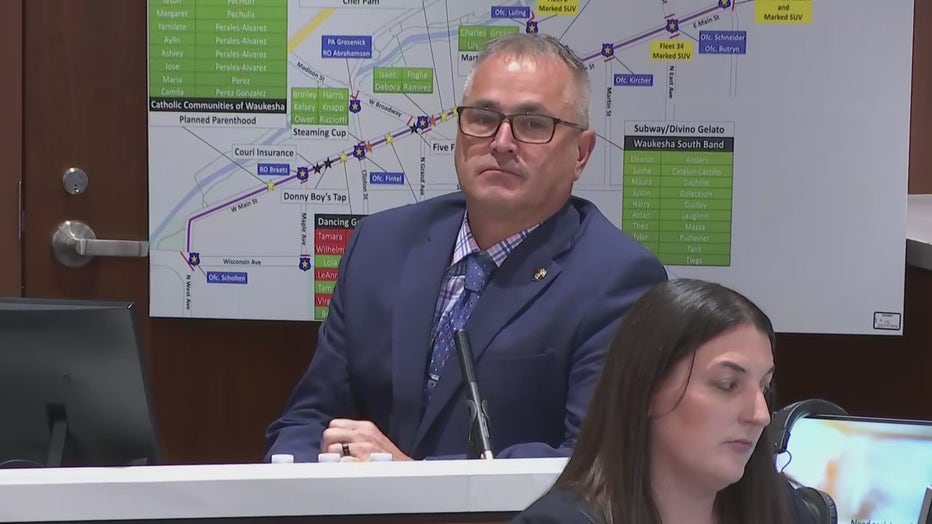
Waukesha Police Detective Thomas Casey
Some of the videos captured the license plate of the red SUV involved in this case. Casey testified police also found a music video on social media where Brooks was recorded next to the SUV with matching plates.
The detective testified that the SUV was found on Maple Road and that officials got a key from Brooks. At that time, Casey said, the red SUV was in processing, so he took the key there and it worked the door lock and the ignition lock of the vehicle. Casey also told jurors Brooks' fingerprints, the three women he has children with and Brooks' mother all identified the suspect in the parade incident as Darrell Brooks. However, Brooks objected to "being called that name."
"That's the name he's always gone by," Casey said.
The jury was shown video of the backyard of Dawn Woods, Brooks' mother, which showed a red Ford Escape – the type of SUV in question. That video was dated 1:26 p.m. on Nov. 21, 2021 – the afternoon of the parade attack. Casey testified that Woods gave police the video that night.
Brooks began his cross-examination of Casey around 10 a.m. During this cross, Brooks argued no one can tell who has their back to the camera in the photo that had been shown in court. Casey said he watched the entire video, and he testified it was indeed Brooks.
The state initially showed a still from the music video with Brooks' back to the camera but later showed the whole video.
Casey further testified that he learned Brooks had use of the SUV at the time of the attack. He also said he had been to Brooks' mother's house to talk to her and knew the video of the SUV in the backyard on the afternoon of Nov. 21, 2021, was from that house.
Casey again testified about what he saw at the parade scene.
"I remember a horn beeping and (Brooks) driving into me and not stopping when I pounded on the vehicle," said Casey, describing Brooks as looking angry. "I've been driving a long time. When people beep their horns, they are late or angry. That's why I concluded they were angry."
Casey added it was a possibility that someone would beep their horn to get out of the way.
Brooks gets angry after state shows music video
The judge sent the jury out mid-morning Thursday for a legal discussion that focused specifically on the video prosecutors say Brooks appears in. Casey testified it was taken from Brooks' Facebook page. Brooks described it as "mind-boggling," saying he had never seen that video before, and it wasn't previously admitted.
"When was this video made an exhibit?" Brooks asked.
Opper argued the exhibit was included with the initial discovery materials sent to Brooks' former attorneys. Brooks again argued this video was never part of the information he received.
"I see what you people are trying to do, and it's not fair, and it's not right," said Brooks. "That video was not part of (initial discovery)."
Judge Dorow said she was satisfied with the state's offer of proof that the video was previously submitted to counsel. Brooks asked if prior counsel could testify to that.
Dorow asked Brooks if he was familiar with the video, and Brooks asked what that had to "do with it." The judge noted it was a music video that Brooks was in, along with the red SUV.
"That video is relevant for a number of different reasons," said Dorow, adding that it would go to the identification of Brooks, the identification of the vehicle.
The judge noted Brooks "opened up the door" to this evidence during his cross-examination of Detective Casey regarding Casey's ability to identify Brooks.
"And when I say identification -- specifically as to Casey's opinion of whether that's you in the video," said Dorow, adding, "It's up to the jury to determine that."
"You directly attacked the credibility of Detective Casey through his knowledge of it and his identification of you in it because the still image of you in it was your back," said Dorow.
Brooks wanted to know why this video was made an exhibit "out of the blue" on Thursday morning.
Darrell Brooks trial: Detective Casey presents state's final testimony, evidence
Darrell Brooks trial: Detective Casey presents state's final testimony, evidence
Opper gets emotional
This led to an emotional statement from DA Opper regarding Brooks' actions in court.
"He challenges the court's authority repeatedly," said Opper. "This court absolutely has the ability to tell him to sit down and be quiet. You haven't done that, and we know why you haven't done that. We respect that."
Opper noted, as Dorow did, that the video was relevant based on Brooks' questioning of Casey challenging Casey's ability to identify the person with their back to the camera in the still shot.
"Trials are fluid," said Opper. "When he opened the door to that, we came up with the video, which Casey testified repeatedly as to how he know that was Mr. Brooks because he had seen the rest of the video."
Opper said she originally wasn't going to ask for the audio to be played but Brooks "pressed it again."
Darrell Brooks trial: Waukesha County DA Sue Opper reacts to Brooks' actions in court
Darrell Brooks trial: Waukesha County DA Sue Opper reacts to Brooks' actions in court
"His voice and his manner of speech would help the jury identify..." said Opper. "You smartly asked me to play it without the audio. This is all to the benefit of this defendant. He doesn't like it because the evidence is stacking up and stacking up. Whenever it does, his response is to accuse you and the prosecutors of being unethical."
Opper added that, "There is nothing in law that prevents me from pulling something out right now and making an exhibit."
"There is no law that I can't make an exhibit on the fly," said Opper.
Brooks got upset and started yelling about the prosecution laughing throughout the trial.
The judge admonished both parties.
Brooks responds
Brooks then argued Opper had been "laughing and talking under her breath the whole trial," telling the court, "I'm not an idiot."
"Why is something always funny at that table?" Brooks asked the judge.
"I think I deserve a chance to rebut what was just said," said Brooks. "For her to sit there and play this off…she must think I'm an idiot."
"That is not what happened," Dorow said as Brooks covered the microphone and laughed.
He told the court that Opper had just admitted on the record that she just made the exhibit up that morning. The judge called that a mischaracterization and asked for a legal basis for his objection.
"So I'm just supposed to come up with that off the top of my head?" asked Brooks.
"Yes," said Judge Dorow.
"That's ridiculous," said Brooks.
"You're representing yourself. It's not ridiculous," said Dorow.
The judge then put Brooks on notice regarding his interruptions.
Darrell Brooks trial: Judge Dorow, defendant spar over evidence, testimony in the case
Darrell Brooks trial: Judge Dorow, defendant spar over evidence, testimony in the case
Judge cuts off discussion
Before the morning break, the judge tried to address two other issues that came up during Brooks' cross of Casey. First, questioning by Brooks related to Casey speaking with Brooks' mother, Dawn Woods, in August, and references made to Brooks' niece and nephew. An objection by the state was sustained by the judge during cross.
The second issue related to questioning regarding Casey's search of Brooks' jail cell.
"Do you want the opportunity to question Detective Casey about these topics?" Dorow asked the judge.
Brooks would not answer the question and continued to argue with Dorow.
The judge eventually cut off the discussion and put the court into recess.
Music video exhibit addressed
Upon return from the morning break, the court addressed Brooks' arguments regarding exhibits, specifically the music video.
"I don't think what I say doesn't much matter," Brooks said. "What I have to say about anything doesn't matter."
"This court takes your position on legal argument," Dorow said as Brooks interrupted. "You make disparaging remarks, roll your eyes. Just previous to the break I couldn't get a word in. You wanted to debate decisions already ruled on."
"Did I raise my voice? Was I frustrated? I absolutely was," Judge Dorow continued. "I just wanted to get through some issues outside the presence of the jury. That's the proper procedure."
"There is nothing improper about what the state did, and I want to make that record very very clear," said Dorow.
"Trials are fluid," the judge said. "Things happen. Parties can open the door to what might be inadmissible evidence. For example, this court made pretrial warnings related to other acts evidence (this relates to information about other cases involving Brooks not being admissible in this trial). You came close. I had the witness (Casey) turn to me and say, 'I don't think I can answer that.' Casey understood his obligation to honor the pretrial rulings. I bet that's happened a half a dozen times. That's to protect your rights, sir."
Brooks' opening statement
After lunch, Brooks cried as he delivered his deferred opening statement to the court, telling the jury he was speaking "from the heart."
In it, he didn't provide details about what happened or lay out his defense, nor did he reveal who he would be calling to testify.
He began by telling the jury, "There's two sides to every story."
"I’ve watched for a year about the countless narratives, and finally, everyone gets the chance for the full story," Brooks said. "You won’t hear me try to argue facts. This was tragic."
Brooks choked back emotion as he continued to present his opening statement.
Darrell Brooks trial: Brooks presents his opening statement to the jury
Darrell Brooks trial: Brooks presents his opening statement to the jury.
"This incident was not planned. It was not intentional," Brooks said. "There’s been a lot of suffering involved in this incident; a lot, obviously, with the families."
Brooks asked the jury to "keep in mind" the power that they have, saying it has been a "long process for everybody."
"Lot of speculation, lot of ridicule," said Brooks, wiping tears from his eyes. "Words like ‘demon.’ Words like ‘monster'…I know a lot of the time I've been before you, you've seen me with this mask on. I've had my reasons for that, but I feel now is the time that it's important that you see me for who I am. No mask. For who I am. I think this is the moment for that."
"I pray that your eyes and ears remain as open as possible. I understand that you alone decide this case, this matter," said Brooks, addressing the jury. "The power is in your hands – all of you – to determine for yourself what truth is. Thank you."
TESTIMONY: Brooks calls "State of Wisconsin"
Brooks tried to call the state of Wisconsin as his first witness during the presentation of his case-in-chief. He had previously called Juan Marquez out of order during the state's case-in-chief presentation due to the need for a Spanish interpreter.
Dorow denied his request to call the State of Wisconsin to the witness stand.
TESTIMONY: Nicholas Kirby, with Kori Runkel (Brooks' ex-girlfriend's roommate) in Waukesha
Brooks then called Nicholas Kirby, who was with Kori Runkel, the roommate of Erika Patterson, Brooks' ex-girlfriend, on Nov. 21, 2021, in Waukesha.
Runkel testified for the state about a fight near Frame Park that preceded the attack involving Brooks and Patterson. Runkel said she was also present, along with a "Nick."
"Did you ever go to a park?"
Brooks asked Kirby.
"No," said Kirby.
Brooks asked Kirby about making reference to knowing Darrell Brooks a week before.
"She showed me your rap sheet…" said Kirby of Patterson, whom Kirby said he had known for a couple weeks.

Nicholas Kirby
"I’ll stop you unless you want to go there – about priors," warned Judge Dorow.
Brooks asked about Kirby's meeting up with Patterson Nov. 21, 2021.
"We were walking towards the area where Erika was walking and saying she was being attacked," said Kirby.
Kirby said prior to that, he got a call from Patterson.
"When she said she was in trouble, I ran to where she told me to go," said Kirby.
Brooks asked if he provided a description to police of who was assaulting his friend. Kirby said he had a description of the vehicle.
"Ms. Patterson told me over the phone she was in a red SUV," said Kirby. "There aren’t many women in Waukesha screaming from a red SUV."
As he approached the area, Kirby said he heard Patterson scream.
"That's what caught my attention," he said.
He said "Patterson doesn't know Waukesha" and that she knew she was on White Rock but wasn't sure how far down she was.
"It wasn’t until I saw the red SUV parked in front of the apartments that I knew where she was there," said Kirby.
Kirby testified that Runkel saw Patterson before he did and said, "She's over there."
"We went across the street, and there was Ms. Patterson, hobbling down the street with fluid on her leg," said Kirby.
Brooks asked if, while walking with Runkel, he saw Patterson in the SUV. Kirby testified Runkel was with him when the phone call came in about Patterson being in trouble. He said he would assume if someone told him they were in a vehicle, they were in a vehicle. He said Patterson may not have been in the vehicle when he got there.
Referencing the video, Brooks pointed to people seen walking in the area and asked if Kirby remembered people in that area near White Rock School.
"I was only focused on the one, and that was the one in danger," said Kirby.
He said he could not see Patterson at that point.
Kirby said he was on the phone with Patterson when he was near White Rock and Hartwell, and she said she was near some red apartment buildings. He still could not see Patterson.
Brooks then pointed to Kirby and Runkel seen walking past White Rock School in the video. They still could not find Patterson. Kirby said he was trying to call her at that point, and she wasn't answering.
"That scared me, so I told Kori to keep an eye out and keep looking for her, while I kept calling her," said Kirby.
Kirby said Runkel finally spotted Patterson near Frame Park and a boat launch. They grabbed her and started to leave.
Brooks asked if Patterson was inside the SUV. He said she was not.
Brooks followed up by asking when, if at all, he saw Patterson in the vehicle. Kirby said she did when she went into the vehicle to grab her things.
Kirby said the first time he saw the red SUV was after zig-zagging up White Rock with Runkel. He said it was parked in front of some apartments, and Patterson came from the passenger side. He assumed she had just gotten out of the vehicle. Brooks asked if he knew that for sure.
"I am not actually sure if she was in the vehicle at that time," said Kirby. "I was just going off of what she said on the phone, so my assumption was that she was in the vehicle."
Brooks asked to play a different video previously admitted as a state exhibit to see if it might offer a better view of Kirby and Runkel coming into contact with Patterson.
After the video was played, Brooks asked if it showed Kirby and Runkel running toward the SUV as it drove away. Kirby said "yes." He was asked where Patterson was at this point.
"I didn’t see her right away. Kori did, and she just told me she was in a red car, so that’s what we were looking for," said Kirby.
Brooks asked if Patterson was inside the vehicle at that time.
"I do not recall," said Kirby.
1-on-1 with Darrell Brooks' defense witness Nicholas Kirby
FOX6's Bret Lemoine spoke one-on-one with Nicholas Kirby, the first man Darrell Brooks called as a witness Thursday as he began presenting his case-in-chief. Kirby said he feels partially responsible for what happened at the parade.
He added that he did see the owner of the vehicle get out of the vehicle, "and that was my primary concern."
Brooks backed things up, asking why they ran toward the SUV.
"Ms. Patterson is a mutual friend of ours. She said she was in trouble. I don’t play around with people who are in trouble," said Kirby.
Kirby then testified about the "physical altercation" between Brooks and Ms. Kori and Ms. Erika. He said he was worried about Patterson getting hurt, so he stepped between then and told Brooks he needed to leave.
Brooks asked whether there was a knife involved.
"No, that is a miscommunication, and I will clarify that," said Kirby.
Dorow stopped Kirby, asking him to wait for Brooks to ask a question.
Brooks asked if Kirby saw Patterson get back into the vehicle. He reiterated that he saw her reach into the vehicle for something. He said he did not see her get into the vehicle.
Kirby said his black jacket he was wearing in the video "hit the ground" as soon as Brooks "started going for the two women."
Brooks asked why.
"Well, if the court don’t hate me for it, I’m just gonna say it’s a good thing there were two women in my way at that moment in time," said Kirby. "That means when my jacket comes off, trouble is going to happen, especially if you are going to try to assault a woman in front of me."
Going back to the report of the knife being involved in this fight, Kirby said, "That was not put into a report. That was a miscommunication between me and an officer. I had been knifed earlier that week and had 12 stitches in one hand. I said, ‘Now, I have a friend being assaulted, and I need back up here.’"
He said when police stopped and asked if there was a knife, Kirby said, "No, there was never a knife involved."
Brooks asked if Patterson ever said the name of the person who assaulted her.
"She was meeting one person that day, and I knew exactly who it was because she had shown me his picture and rap sheet prior. Her child’s father is who she was meeting up with that day, and I told her multiple times, ‘That’s not a good idea. I have a bad feeling about this,'" said Kirby.
Brooks asked questions about the police report, including if Kirby recalled stating that the "alleged defendant" tried to punch and push him.
"The alleged defendant being you, yes -- attempted to," said Kirby.
Brooks asked whether the video showed that.
"No, it does not," said Kirby. "It shows me pulling two women away from the situation."
Brooks asked why he would tell detectives that the "alleged defendant" tried to assault him.
"Probably because there were three people’s fists flying," said Kirby, adding he was trying to protect the two people he cared about.
Brooks asked about the parade.
"I wasn't attending the parade," said Kirby. "I was in the area that the parade route was in. My street is the parade route."
Brooks asked if he saw anyone injured that day.
"Yes, after I walked back through that area, I saw a red SUV take off like a bat out of hell down Main Street and go through a crowd of people," said Kirby.
"The question was, did you see this take place?" said Brooks.
"With my own freaking eyes, yes. How many times do I have to say yes for you to understand it? Y-E-S spells yes," said Kirby.
The defendant asked if the video showed three people throwing punches. Kirby said three people were throwing hands: Erika, Kori and Brooks. He said you'll see three pairs of hands go up toward one another in the video.
After the fight, he said they walked back down White Rock to Main, cutting through the neighborhood to go back towards the Women's Center in Waukesha where Patterson and Runkel lived.
"However, things took a drastic turn when the red SUV that I’ve described multiple times went down the opposite direction…then turned back around and came back down…" said Kirby.
The judge struck that response.
Kirby said he was stopped by an officer partway down White Rock, and Kirby let them know they needed to be on the lookout for a red SUV. The officer asked if there was someone with a knife. Kirby said he showed the officer the stitches in his hand and said "no."
"I'm guessing that's where the miscommunication with the knife came in," said Kirby.
Brooks asked if Kirby was injured during the fight. He said he ripped three of the stitches in his hand, but he said that was more from pulling Runkel away from Brooks.
After dropping Patterson and Runkel back at the Women's Center, Kirby said he started running back toward Main Street to see if he could avoid the parade traffic.
"And that’s when I saw the red SUV go down Main Street," said Kirby.
The state had no cross.
In a one-on-one interview with FOX6 News after his testimony, Kirby, a defense witness, said he believes Brooks is "100% guilty," and Kirby said he, himself, feels responsible for the parade attack because he told Brooks to leave after the fight near Frame Park.
TESTIMONY: Heather Riemer, Waukesha Christmas Parade attendee
Brooks' next witness was Heather Riemer. Riemer was at the Waukesha Christmas Parade with her husband, three friends and one of their children.
Following her testimony, we learned Riemer was called out of order by Brooks due to unavailability on Friday.
She described a "commotion" during the parade and a red SUV "driving through faster than all the other cars in the parade." She said the horn was honking.
"Well, I heard honking. I’m not positive if it was the red SUV or another car," said Riemer.
Brooks asked Riemer why someone would honk a horn, in her opinion.
"To alert somebody," said Riemer.
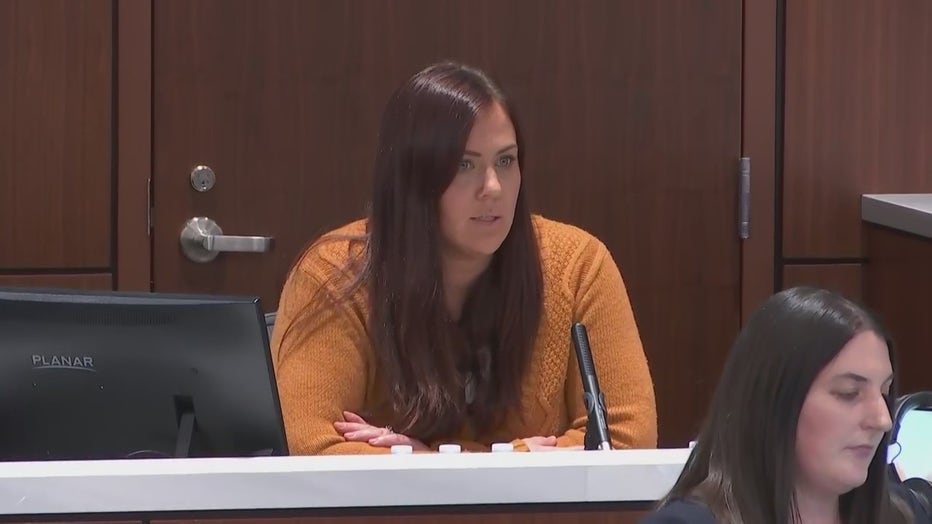
Heather Riemer
She said she did not see the driver of the vehicle and could not recall whether the windows were tinted. She was not able to see into the SUV. She did not get a license plate number. She could not recall if the windows were up or down. She said she did not see anyone hurt by the vehicle.
On cross, Assistant District Attorney Zachary Wittchow asked Riemer to look at the defendant.
"Have you ever seen that man before?" he asked.
"Yes," said Riemer. "As we were driving to the parade, we were coming to a stoplight, and we saw the red SUV coming down the wrong way on the road and I slowed down because the car in front of me started to back up to let him through."
She said this happened outside a gas station.
Wittchow asked if she saw Brooks at that time. Riemer answered that she didn't know the name at that time but said "yes." She identified him as the defendant in court.
On redirect, Brooks asked Riemer questions referencing the map of the gas station. She said "yes" when asked if the SUV she saw at the gas station was the vehicle she later saw at the parade.
Brooks asked how she knows the driver at the gas station was the driver at the parade if she didn't see the driver at the parade. She said the vehicles at both scenes were the same color, make and model -- a red Ford Escape. She added that she knows "a decent amount about cars."
Brooks' last question to Riemer was whether she knew whether the driver of the red SUV was the same at the gas station and the parade. She said "no."
FRIDAY, Oct. 21
Darrell Brooks brought nine more witnesses for his defense to the stand in his trial on Friday.
At the end of the day Thursday, there was talk that all testimony could be wrapped up by the end of Friday. Brooks himself said: "That's not gonna happen."
By the end of Friday, the judge said everyone who had been subpoenaed to testify had done so, but Brooks himself still had the right to testify or not. There was also talk about Brooks calling his mother, Dawn Woods, to the stand.
As soon as court went into session on Friday, Brooks immediately asked the court for paperwork he said he was missing related to the first witness he planned to call Friday. Brooks said he would not call any witnesses until he had that paperwork in hand, but Judge Jennifer Dorow said it was Brooks' responsibility to have what he needed for his own defense.
"So what am I supposed to ask him?" said Brooks. "Want to come look at the box yourself? Trying to always pull a fast one."
Dorow demanded that Brooks "call your next witness, please," and Brooks told the court there was a "rush to judgment," holding up Dorow's oath of office.
"You are refusing to call your witnesses," said Dorow. "It is now 8:44."
Brooks then brought up Detective Casey's testimony Thursday when he was recalled by the state.
"Casey testified yesterday for the second time under oath and showed the backyard of my mother’s home. Casey said he had been to my mother’s home and didn’t even speak to my mother," said Brooks.
"You want to add your mother to your witness list?" asked Dorow.
"Yes," said Brooks.
Dorow told Brooks he could call Detective Casey again if he wanted.
Darrell Brooks trial: Friday fireworks to start the court proceedings
The court proceedings in the Darrell Brooks trial began with fireworks between Brooks and the judge.
TESTIMONY: Douglas Kolar, attended parade with daughter
First to take the witness stand on Friday for the defense was Douglas Kolar. He attended the Waukesha Christmas Parade with his daughter, who was marching in it. Kolar testified about what he saw involving a red vehicle.
Neither Kolar nor his daughter were hurt in the parade attack.
"As we were approaching White Rock I noticed a vehicle coming through where the parade participants were going. It was a red vehicle. It was honking its horn," Kolar said. "Between two of the groups, it veered to the left. A police officer attempted to stop the vehicle – reached for the door handle. The vehicle started to speed off."
Brooks asked Kolar if, as the vehicle sped off, it looked as if it were trying to avoid hitting people. Kolar answered: "At that point, yes."

Douglas Kolar
Kolar testified after he saw the vehicle speed off, he grabbed his daughter and walked as fast as they could to their car.
The witness described the vehicle as a "red SUV" – later adding that the rear windows were tinted.
Opper asked a couple of questions during cross-examination. One referred to the manner in which the red SUV was being driven. Kolar answered "yes" to whether it was driving erratically.
Opper also asked Kolar about a description of the person who was driving the vehicle. Kolar described the person has a Black male with dreadlocks and tattoos.
TESTIMONY: Steven Guth, Waukesha police detective, talked with Patterson after fight near Frame Park
Waukesha Police Detective Steven Guth was next to take the stand. Guth previously testified for the state.
Friday, the detective testified about making contact with Erika Patterson, Brooks' ex-girlfriend and mother to his child.
"(Patterson) stated she met with Brooks at Frame Park, she didn’t give him money, and he slapped her in the face," Guth said. "The next day she clarified it happened on (Nov. 21). He took her phone because she thought he was talking to other guys."
Brooks asked the detective about a fight near Frame park, and if he recalled recovering a knife:
Guth: "There was no knife."
Brooks: "Reported as a knife fight?"
Guth: "That's how it was originally reported and communicated to dispatch…She did not give me all the details of the incident initially."
Brooks: "Do you recall why?"
Guth: "I don't know why she didn't…She told me she was extremely afraid of you and that's why she didn't tell everything."
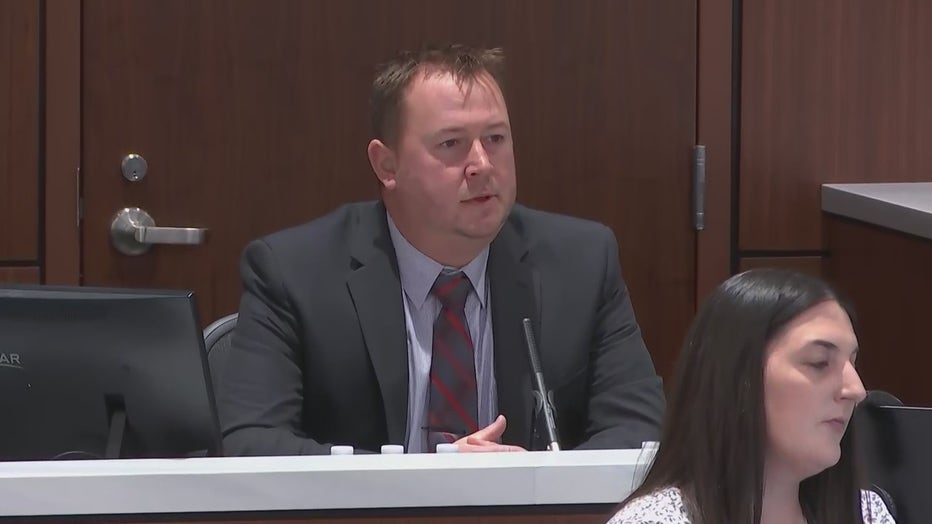
Steven Guth, Waukesha Police Detective
Brooks had no other topics for questioning Guth, and the state had no cross-examination.
Dispute over witness order
Mid-morning, after excusing the jury, the court asked Brooks to provide his next witness. It was expected to be Patterson, but the defendant appeared to be stalling.
Dorow told Brooks she could force him to call the next witness, or she would be released from her subpoena. Brooks questioned if the judge had that authority, and she explained that she did.
"I don't take that as a game. This is not a game for me. Nothing about this is a joke. It's disrespectful to me that you'd – your life is not on the line, mine is," Brooks said.
When the jury returned from break, Brooks again raised the "subject matter jurisdiction" claim that he has repeatedly discussed throughout the trial.
Darrell Brooks trial: Defendant has an outburst about the order of his witnesses
Darrell Brooks trial: Defendant has an outburst about the order of his witnesses.
TESTIMONY: Erika Patterson, Brooks' ex-girlfriend
After a break, Brooks called Erika Patterson to the witness stand. Patterson had previously been called to testify by the state.
The line of questioning from Brooks centered on an incident that happened near Frame Park before the Waukesha Christmas Parade. Patterson testified she had argued with Brooks. Brooks pressed Patterson, asking whether she was forthright with information when she spoke with Guth about the Frame Park incident.
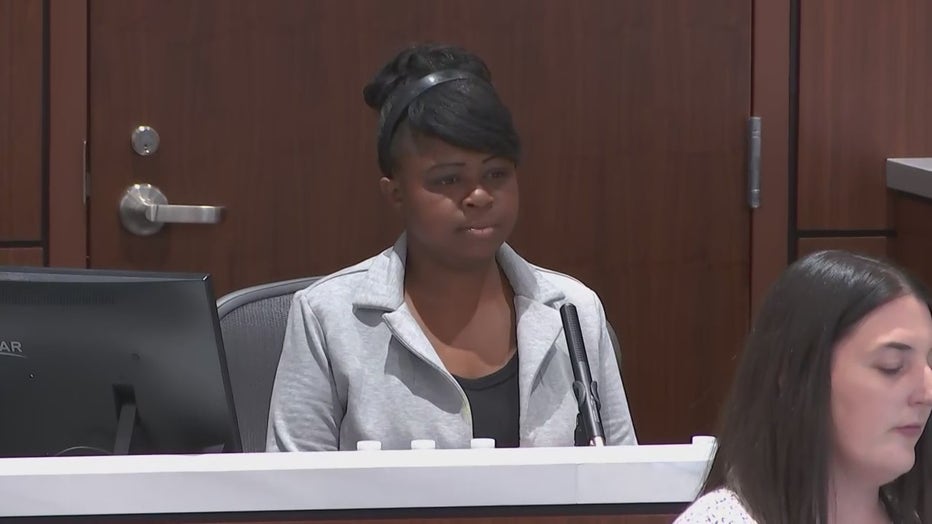
Erika Patterson
Patterson: "I just didn’t tell him everything right away."
Brooks: "Why not?"
Patterson: "I don’t know, Mr. Brooks."
Patterson continued to testify about how she knows Brooks, including for how long and where they met, topics also discussed during her testimony for the state.
Argument over questioning of Patterson
When Brooks attempted to introduce new pictures into evidence. Brooks was trying to dispute testimony that there had been no contact between Patterson and Brooks since the night of the parade attack.
"You stated there’s been no contact. How would the alleged defendant obtain photos if they’d been no contact?" asked Brooks.
Brooks also asked Patterson, "If you’re so deeply afraid why send pictures?"
Brooks said he had a document that showed a battery incident involving Patterson on Nov. 20 did not happen.
"When did you receive this document? I want to see the document," said Dorow.
That set off another chain of exchanges between Dorow and Brooks.
"Stop it. You are a public servant. Your job is to be the umpire," Brooks said.
Darrell Brooks trial: Defendant, judge exchange about the admittance of evidence
Darrell Brooks trial: The Defendant and Judge Jennifer Dorow had a vigorous exchange about the admittance of evidence Brooks wants in the trial.
Dorow noted the document was in reference to Count 77, a battery count that was dismissed.
"She did not have any visible marks or injuries from that event," said Opper. "We didn’t want to confuse the record if there was a battery on 11/20."
"Now you are saying there’s some document that goes to the credibility of this witness," said Dorow. "I need to ask a few questions to determine the relevancy."
"Why do you believe the letters came from Ms. Patterson?" asked Dorow.
"I have a child with this woman. How would I not know her handwriting?" said Brooks.
"Why do you believe they are from her?" asked Dorow.
"Because they are from her," said a frustrated Brooks. "I didn’t get these pictures from anyone else."
Wittchow told the court he believed the pictures were an effort to "make Patterson look like a bad mom," noting that Brooks impregnated Patterson when she was a minor.
Following this exchange, the judge called for an early lunch break.
"A rough day"
When court returned to session after the early lunch break, Brooks was in the adjacent courtroom. Dorow explained why, noting that it had been "a rough day, to say the least."
"In my almost 11 years on the bench… to say that this is the most challenging of my career would be an understatement," said Dorow, noting Brooks' "tone, demeanor and decorum."
"It’s apparent when the jury enters and exits the courtroom Brooks references subject matter jurisdiction. His objections have been noted -- well documented. Once that objection is made, it’s preserved. Brooks brings this up in front of the jury to distract and delay. When there is a ruling Mr. Brooks disagrees with, he has a pattern now asking for verified law -- debating the topic once again or turning us away from that by bringing up another topic. He tries to divert things down a different path to delay or disrupt."
She called Brooks' behavior "volatile" and said he was "blatantly pushing the limits of the court."
After initially saying he did not want to return to the main courtroom, there was soon a break to bring him back in.
Brooks was not able to provide an offer of proof as to why the judge should allow the document/letter discussed in connection with Patterson's testimony.
"What topics were you generally going to question her about?" asked Dorow.
Darrell Brooks trial: Judge Jennifer Dorow describes Brooks' behavior during Friday's proceedings
Darrell Brooks trial: Judge Jennifer Dorow describes Brooks' behavior during Friday's proceedings
Brooks made hand gestures.
"There was so much that happened in the last hour or so," said Brooks.
"I need an offer of proof on the new topics," said Dorow.
Brooks told the court he didn't recall what Patterson testified to when she was a state witness, indicating it was a long time ago.
"I trust you are prepared," said Dorow. "These are your witnesses."
Judge threatens to end Brooks defense -- no more witnesses
The judge eventually ended questioning of Patterson.
"Man, I object to that, too. I might as well have stayed over there. Just put me over there. You hold me in contempt," said Brooks, of the adjacent courtroom.
"You’re not in contempt," said Dorow.
There was another break to again move Brooks to the adjacent courtroom, where he asked about subject matter jurisdiction.
"So I have to be quiet like a little kid," said Brooks.
There was no cross of Patterson from the state, and she stepped down from the witness stand.
The jury was then excused yet again to bring Brooks back into the main courtroom. This, after Dorow warned to end his defense entirely.
"If you don’t call your next witness, you’ll forfeit your right to call any other witnesses," said Dorow.
"Mr. Brooks, all I’m asking is you conduct yourself with dignity, decorum and respect. You need to ask me to come back into the courtroom," said Dorow.
I simply do what I do because I don’t have the understanding," said Brooks. "I feel very, very disrespected. Of course, it’s going to make me upset."
Brooks was then brought back into the main courtroom, again.
Darrell Brooks trial: Brooks argues with judge from adjacent courtroom
Darrell Brooks trial: Brooks argues with judge from adjacent courtroom
TESTIMONY: Deanna Aldrich, lives on Maple Avenue in Waukesha
Brooks called Deanna Aldrich to the stand. She lives on Maple Avenue in Waukesha and testified she heard a "large thumping noise in my neighbor's yard." When she came out, Aldrich stated she saw an SUV that was "smashed to smithereens."
Aldrich testified she did not have her glasses on, so she could not clearly see the person who got out of the SUV. She was "running in and out" of her house to get her glasses.
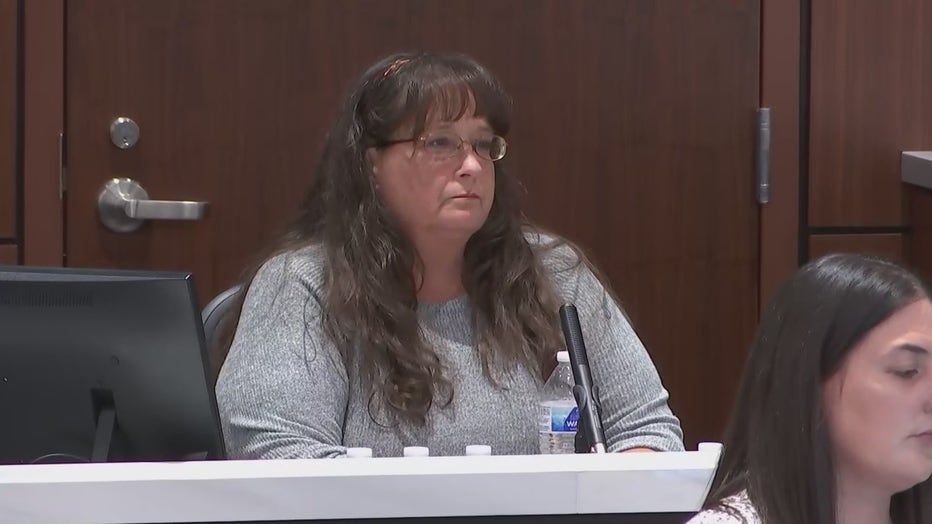
Deanna Aldrich
Brooks asked Aldrich if she recalled whether the SUV had any tinted windows; she said she did not. Aldrich further testified that she did not learn what the loud noises were before she saw the SUV.
Aldrich added that she was aware of the parade, but did not attend it. There was no cross-examination from the state.
TESTIMONY: Christopher Bertram, saw ‘smashed up red car,' heard gunshots
Next to testify for Brooks was Christopher Bertram, a person stated he saw a "smashed up red car" on the evening of the Waukesha Christmas Parade.
Bertram stated he did not see if the vehicle had any tinted windows, and did not recall a description of the driver. However, he testified he saw the driver reach down and grab something – possibly a gun.
Brooks asked Bertram if he recalled telling law enforcement about hearing a lot of gunshots.
"Yes, sounded like it came from downtown," Bertram said. "A full magazine."
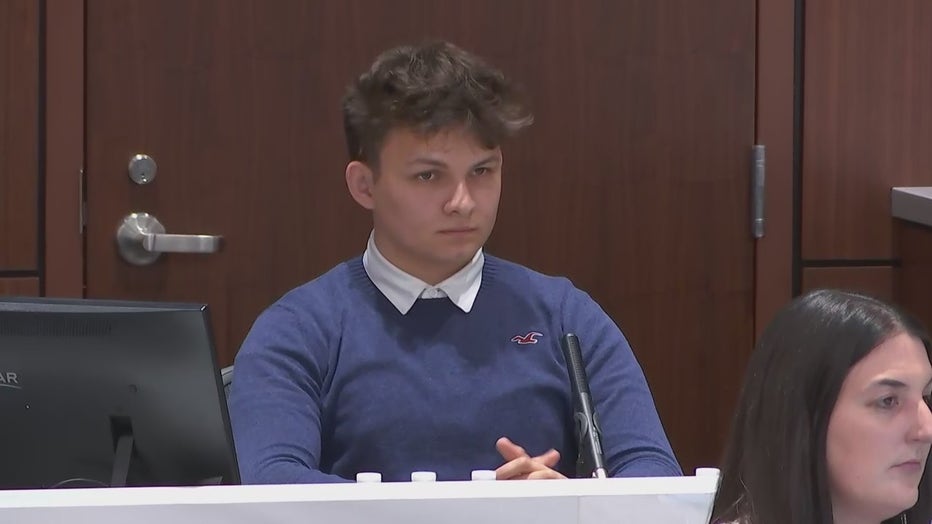
Christopher Bertram
The state did not cross-examine Bertram.
Brooks stares down Judge Dorow: 'Frankly, it makes me scared'
Brooks became upset due to the state declining to cross-examine his witnesses. He also suggested that the witnesses taking the stand were coached by the prosecution on their answers.
"All of the sudden the state doesn’t have questions – rush through the case. I see through it. I’m far from an idiot," said Brooks.
Moments later, Brooks slammed his hand on the table and began staring very intensely at Dorow, who quickly called for a recess.
"This man is having a stare-down with me," the judge said. "Frankly, it makes me scared."
Darrell Brooks trial: Defendant raises legal issue, stares down judge after arguing his point
Darrell Brooks trial: Defendant raises legal issue, stares down judge after arguing his point
TESTIMONY: Jason Hayes, attended Waukesha Christmas Parade
After arguments over who would be his next witness, Brooks called Jason Hayes to testify. Hayes said he went to the parade as a spectator with his daughter and was not injured in the attack.
Brooks asked Hayes if "anything unusual" caught his eye the day of the parade, Nov. 21, 2021. Hayes said a "red truck" came through near Main and White Rock. He said the vehicle "honked and swerved," but did not know why.
Hayes further testified that it was a single "honk" and that he "saw it continue" through the parade. He described what he told police in an interview "a couple days after" the parade attack.
"In your opinion, (the SUV) wasn't trying to strike the kids?" Brooks asked.
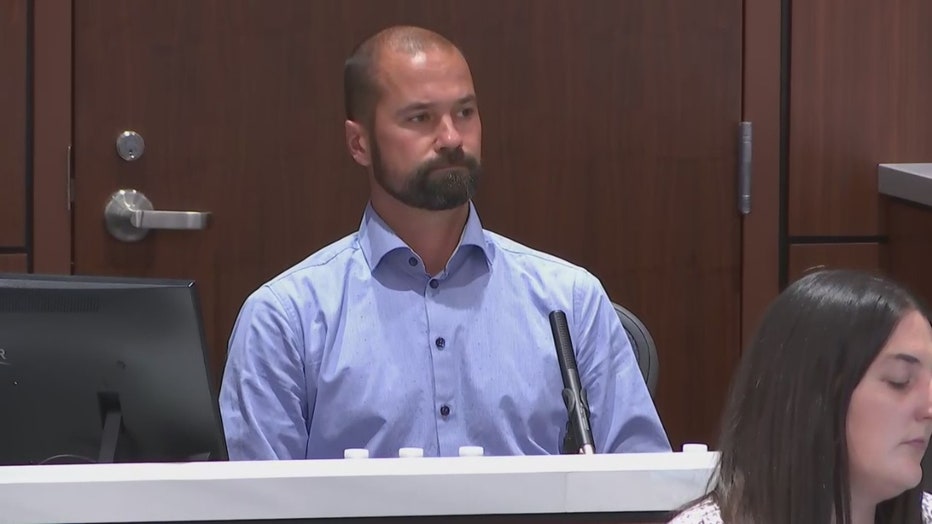
Jason Hayes
"Yes," Hayes said. The witness added that he did not see the vehicle hit anyone.
Opper cross-examined Hayes, asking what he recalled about the incident – such as if the vehicle sped off and if he saw police run after it. Hayes said he thought he remembered seeing an officer run after the vehicle and that the driver had a "dark complexion."
On redirect, Brooks asked Hayes what he would consider a dark complexion. Hayes just repeated the description, Brooks said it was "kind of hard" to describe and asked Hayes if he noticed the driver's clothing or hair. Hayes said no, and was excused.
TESTIMONY: Abel Lazcano, attended Waukesha Christmas Parade
The defendant called Abel Lazcano to testify Friday. Lazcano attended the parade with his wife and daughter and said he came across the red SUV parked on Maple.
Before his testimony, there was a discussion about whether there would be questioning about Lazcano's criminal history, and the parties agreed he could be questioned regarding his seven prior convictions.
Lazcano identified the driver of the SUV as Brooks and said he flagged down an officer at the scene. He did not recall if the SUV had tinted windows.
"Do you remember saying you saw three Black males fleeing the vehicle?" Brooks asked.
"I do not," Lazcano answered.
Brooks asked Lazcano how he found the vehicle on Maple. Lazcano said he was walking with his family back to their car, trying to get them to safety, when he saw it. He added that he found it parked in the driveway of a home. He said he saw a few people standing around the vehicle.
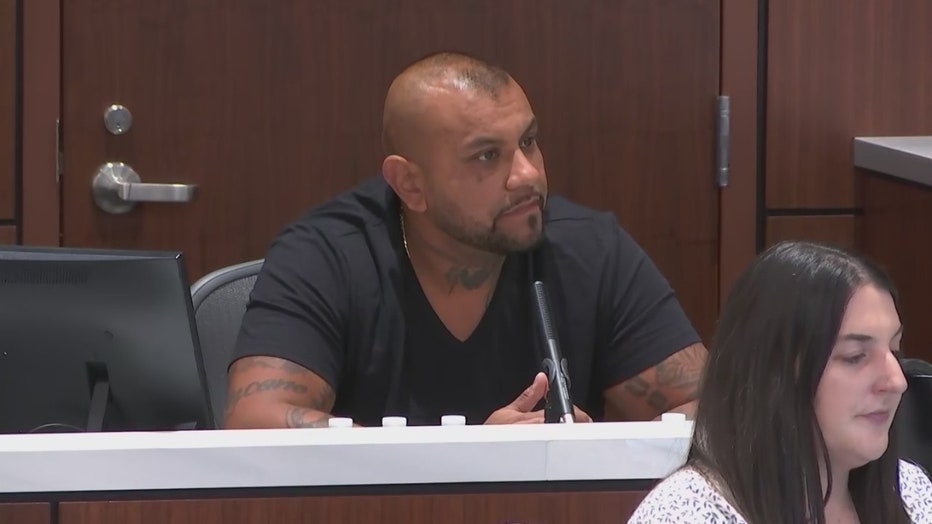
Abel Lazcano
"Do you recall stating that one Black subject was described as tall, blue and black pants, others described as two short Black males wearing sweatpants?" asked Brooks.
"Barely, a little bit of it," said Lazcano.
"Which of these subjects do you remember? Where did you observe those people?" asked Brooks.
"Standing by the vehicle where I spotted it," said Lazcano.
"Just so we have clarity, describe the subjects you saw standing by the vehicle," asked Brooks.
"I don’t remember them … I can’t tell you. That was too long ago," said Lazcano.
"Do you recall why the report says that you advised Detective Moss that there are three Black subjects, specifically Black subjects running from the vehicle?" asked Brooks.
"No, I don’t remember," said Lazcano.
Brooks asked Lazcano whether he told another detective there were three or four people in the SUV as it passed him.
"No, I don't remember that," said Lazcano. "Reason I came up with three to four people...there were two or by the vehicle. I figured they must have been ones trying to hide the vehicle, standing in front of it or close to it."
"Did they look nervous?" asked Brooks.
"They were the only ones not doing much, so yeah, they stood out," said Lazcano, who noted everyone else in the area was running or walking fast.
Brooks followed up by again asking whether Lazcano remembered telling a detective that there were three to four people in the car when it passed him during the parade.
"No, I don't remember that,"
"Any reason why he'd report that?" asked Brooks.
"Like I said, I saw two to three people by vehicle and assumed they were with vehicle," said Lazcano. "I saw the driver because he hit somebody right in front of us."
FOX6 News interview with defense witness, Abel Lazcano
Darrell Brooks called Abel Lazcano to testify Friday. Lazcano attended the parade with his wife and daughter and said he came across the red SUV parked on Maple.
On cross, Opper asked Lazcano if he saw the SUV hit people in the parade.
"It just kept swerving, plowing everybody out of the way until it got to the front of us and hit somebody and did like a cartwheel in the air," said Lazcano.
Opper also asked about how Lazcano came upon the SUV. He was shown an exhibit and identified the vehicle and the area it was in, as well as the people who were standing around it. Dorow sustained an objection from Brooks for speculation.
Again, for the court, Lazcano identified Brooks as the driver. He described people running and said he'd never spoken to Opper.
Upon redirect, Brooks asked Lazcano more questions about the driver he saw. Lazcano said he saw the driver for a "couple seconds" and described the driver as a Black man with a scruffy beard. He also, again, described seeing people standing around the parked SUV.
After his testimony, in a one-on-one interview with FOX6, Lazcano, a defense witness, also said he believes Brooks is guilty.
TESTIMONY: Kathleen Yourell, kids were in the parade
Brooks called Kathleen Yourell to the stand. Yourell testified that she dropped off her kids, who were participating in the parade, at the corner of Main and East.
Upon questioning, Yourell said she did not recall if there were barricades set up. She said she left her kids and was leaving to get to the end of the parade, so she could pick them up. She described what she saw.
"At this time a car was beeping and weaving through around a slight curve White Rock has and then continued on," said Yourell. "Started to move forward, then straight across, thinking it would leave the parade route."
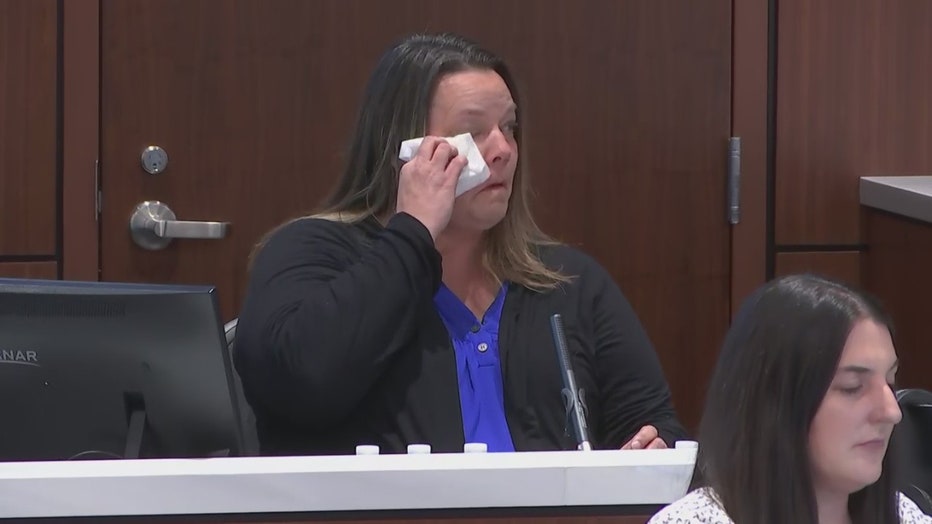
Kathleen Yourell
Yourell said she did not see the driver, did not recall seeing anyone get hit and did not recall if the SUV had tinted windows. She said the vehicle was speeding and was close enough that it "could've easily clipped" her or the people she was with. She was not injured.
Wittchow cross-examined Yourell. She said she was in the crosswalk and that it was clear to her that there was a parade route. She agreed that it was clear that the driver should not have driven into the route.
Yourell became emotional on the stand as Wittchow asked about her four kids, who were all in the parade. She said two of her kids were marching with the Xtreme Dance Team. She did not see her other two kids for days, she testified, because she was staying with her two injured kids in the hospital for days.
TESTIMONY: Katric Babiasz, law enforcement dispatch supervisor, attended the parade
Katric Babiasz, a law enforcement dispatch supervisor who was at the parade, was the ninth and final witness called to testify Friday. She testified that she saw a red SUV and that it almost hit her daughter.
"The vehicle, the driver, was honking the horn," she said.
Babiasz described "gesturing" from the driver. Brooks asked for clarification, and she said she took the gestures as trying to tell people to get out of the way. She said she "looked the driver right in the eyes" and the driver "looked, like, through me." The witness described the driver as having hair "like dreads" and facial hair. She also described seeing barriers positioned along the route – but didn't see if anyone was hit.
"I lost sight of the SUV once it went into a bunch of people," said Babiasz.
Babiasz testified she left the parade after seeing the SUV. She said she was injured – but later specified that she was not physically injured. She said she "didn't want to talk to anyone about the traumatic incident" and did not file any claims.
Brooks asked Babiasz if she thought the SUV was trying to hit anyone.
"Yes," said Babiasz. "I saw that an officer had to get out of the way. He was attempting to stop Mr. Brooks from driving through the parade, and he was – at the last minute – jumped out of the way of the vehicle, otherwise, he would've been struck."
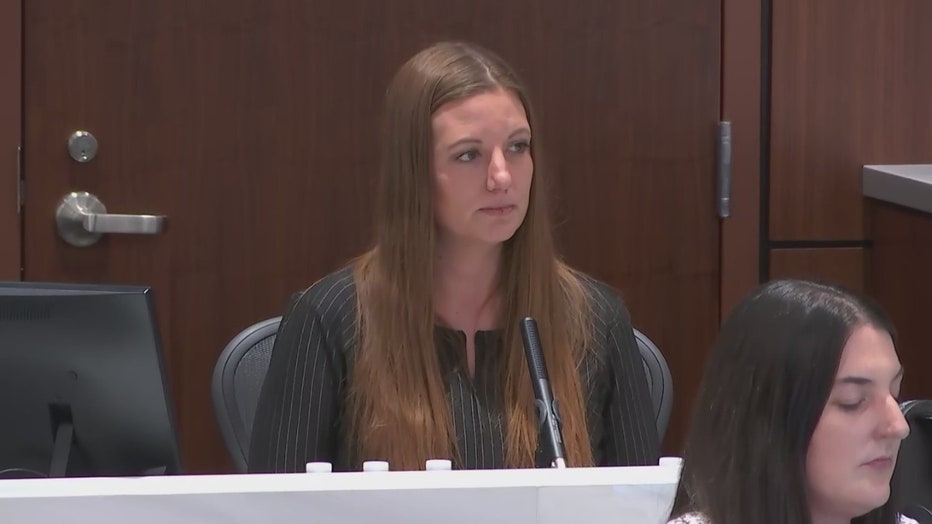
Katrice Babiasz
The defendant then began a line of questioning about Babiasz's subpoena to testify. Dorow explained the situation:
Dorow: "Mr. Brooks, she's here under your subpoena."
Brooks: "What? This is mind-boggling."
Dorow: "I'm asking you to move on."
Brooks: "You're all just ridiculous, man."
Throughout the exchange with the judge, Brooks tried to continue questioning Babiasz – implying the witness was coached on her answers. Brooks added "this is ridiculous" as the judge tried to move him along.
The state cross-examined Babiasz, who said she and her kids were in the roadway when SUV drove through. She said they saw Santa, which marks the end of the parade. Brooks' interruptions continued during cross-examination – his objections overruled.
"Of course, as usual, it's always overruled," he said.
Babiasz further described seeing police try to stop the SUV near Main and White Rock. She added that other people tried to stop it, too. She said it appeared to speed up and that it "drove side-to-side" as it went through the people.
Upon redirect, Brooks asked Babiasz to confirm she saw multiple officers try to stop the SUV. She said she did. Brooks then called Babiasz's recollection into question:
Brooks: "There may be some details you don't recall, so would it be fair to say you don't quite recall the path of the vehicle?"
Babiasz: "No, that is not correct."
Brooks: "What other details do you not recall?"
A member of the state laughed, objecting, asking how it would be possible for someone to state what they do not recall.
Brooks: "Seems almost as if you're recalling what you want to recall and purposely not."
Dorow then sustained an objection that Brooks was badgering the witness. She ordered Brooks to not badger or intimidate the witness, explaining that his facial expressions counted.
"You can't be serious now? What have I done to intimidate the witness?" said Brooks, adding after Dorow's response. "How are you even a judge?"
Brooks continued muttering during jury instructions.
He was then asked if he filled out a subpoena for his mother, Dawn Woods.
"If I want her to be here, she’s going to be here," said Brooks. "All I gotta say is come. She gonna come. That simple."
As the judge tried to get through some housekeeping matters before putting the court into recess, Brooks began yelling at Dorow, telling the judge, "Just do what you got to do so I can get out of here."
Brooks was then moved to the adjacent courtroom again.
With Brooks out of the courtroom, Dorow continued to explain her rulings. She said he was "disparaging the court" and "standing for hours even though I directed him to sit down."
"It was very apparent to this court and anyone watching that Mr. Brooks was not pleased with the witness' answers. He’d roll eyes, make other gestures that, it was apparent to this court he did not like her testimony," Dorow said of her badgering-the-witness ruling. "He was being very argumentative with that witness who again, he called."
Will Brooks testify?
Darrell Brooks trial: Defendant's outburst at the end of Friday testimony
Darrell Brooks trial: Defendant's outburst at the end of Friday testimony
Before going into recess Friday, the judge said the court got through all the witnesses that were subpoenaed to testify for Brooks' defense. Dorow said Brooks gave permission to call his mother as a witness.
The only other witnesses Dorow said she could identify for testimony would be Brooks himself, giving him the weekend to consider whether he would testify or not.
"It is his decision and his decision alone on whether to testify," Dorow said.
If Brooks did not answer whether he would like to testify, the judge said it would be interpreted by the court as a "no," meaning he chose not to testify, given "how the trial has progressed."
Prosecutors said they did not plan to have rebuttal witnesses.
The judge told the state to be prepared for closing arguments during Week 4 of the trial and lengthy (more than 100 pages) jury instructions.
Before court ended, the judge asked Brooks if he had anything to address.
"Why haven't I been given the chance to offer my filings into evidence? I would like every single filing I place into evidence. Every last one of them," said Brooks.
"You all need to cut it out, seriously. Stop it. Seems like all you want to do is gang up, be biased, be prejudiced and gang up.
SIGN UP TODAY: Get daily headlines, breaking news emails from FOX6 News
Brooks also accused the court of making "false records" and violating his First and Sixth Amendment rights.

